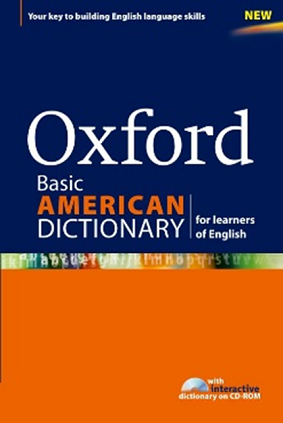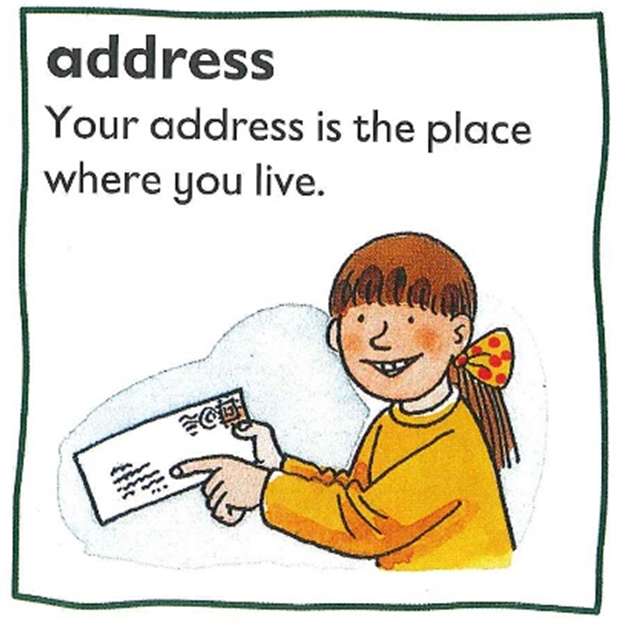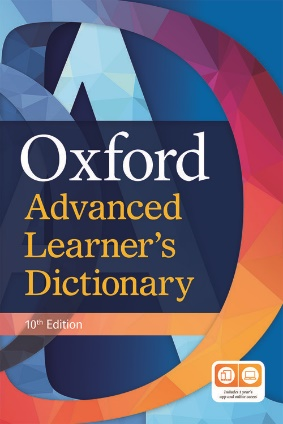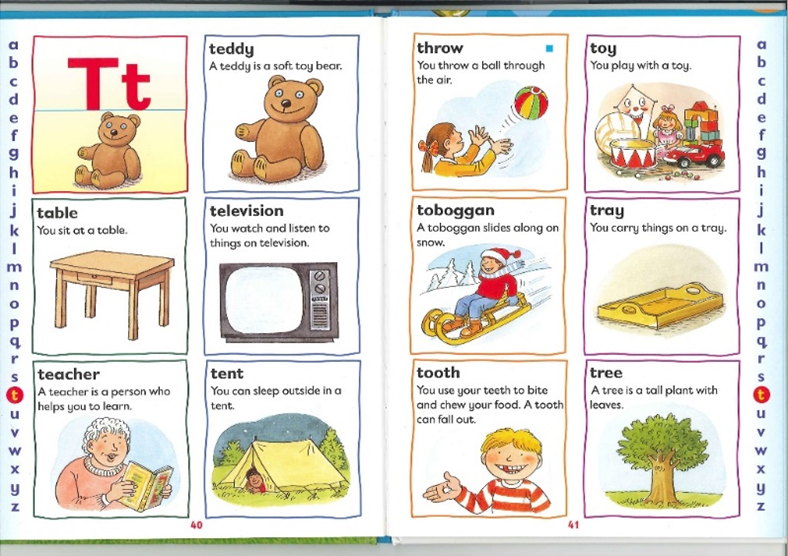Resources and Articles
Getting the most out of OALD
Read Vol.3
In my final article in this series, I will share how to use the Oxford Advanced Learner’s Dictionary to its fullest potential. First, I will introduce some methods for using OALD with intermediate students and learners who are planning to use it in the future. Then, I will explore further ways for advanced users (including teachers) to fully utilize the app’s Full text search function. (For more information about the app, read my previous article.)
Part One: Tips for Using OALD with Intermediate Students and Future Users
OALD is an English-English dictionary for advanced learners. For intermediate learners, other resources such as Oxford Wordpower Dictionary are available. But that doesn't mean intermediate-level learners can't use OALD. Here is a list of ways to help intermediate students get familiar with OALD, and use it to improve their English skills.
1. Try reading the easy parts!
- Example sentences and columns
English-English dictionaries are challenging. Definitions can be dense, abstract, and confusing1. That said, some parts are relatively approachable. In OALD, examples and columns are written in ordinary English, so they are easy to understand. Key English language learning points, such as usage, synonyms, and cultural information, are covered in the various columns (see the table "Columns" at the end of my second article). Learners should read the sections that interest them.
- Encyclopedic information
While early English-English learner’s dictionaries focused on language-related information, more recent publications include encyclopedic information. OALD also contains quite a few entries about people's names, place names, and historical events. These are explained concisely, in plain English, and with relevant information, making learning fun and educational:

2. Review familiar vocabulary!
- Basic language
As is often pointed out, it's good to look up words you have already learned in an English-English dictionary. Since you already know the meaning in your first language, it is easier to understand the definition, and it can be an eye-opening experience for learners. In my Guide to the practical usage of English monolingual learners’ dictionaries (p. 9), I suggested looking up the words not bad, climb, international, and willing in order to draw the reader’s attention to the gap between the Japanese translation and the English meaning. Not bad literally translates to warukunai in Japanese, but the English definition reveals that the phrase in fact has a more positive connotation:
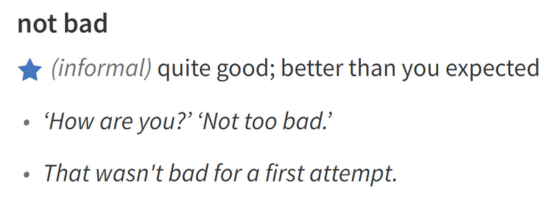
- Loan words found in English
Definitions of words that have entered English from your language should be familiar and easy to read. As far as Japanese is concerned, by entering Japanese as the keyword in the Advanced Search on the CD-ROM accompanying OALD 8, you will find the following Japanese-origin and Japan-related phrases:
aikido, anime, Bon, bonsai, bonze, bullet train, bushido, butoh, futon, geisha, hiragana, ikebana, ju-jitsu, kabuki, kanji, karate, katakana, kendo, kimono, manga, miso, ninja, Noh, obi, origami, pachinko, romaji, sake, sashimi, shiitake, Shinto, Shogun, soy sauce, sumo, sushi, tatami, tea ceremony, tempura, teriyaki, wasabi, yukata, Zen
As of March 2023, the following phrases have been added to the online OALD2:
bento, cosplay (noun, verb), cosplayer, edamame, emoji, hibachi, kanban, matcha, mecha, ramen, TabataTM, Wagyu, yuzu
3. Check the items in bold!
- Usage patterns
In addition to headwords, OALD also employs boldface. Usage patterns, and prepositions and adverbs used with the headword are highlighted in bold. This makes it possible to check aspects of usage which even advanced students need to pay special attention to, such as whether or not a noun can be followed by an appositive that-clause:

- Set phrases
Set phrases and important collocations used in example sentences are also shown in bold. Where the meaning is not clear, a note in brackets is provided:

It is important to learn these words and phrases in bold, as they are useful for both productive and receptive language skills.
4. Look up anything using Full text search!
I will cover the app's Full text search function more comprehensively in the next part, but it’s worthwhile mentioning here that intermediate users can also use it to search for whatever word or phrase that interests them. For example, if you search for World Cup, you'll find fascinating examples scattered throughout OALD that are both memorable and handy for conversation:
- They crashed out of the World Cup after a 2–1 defeat to Brazil. (s.v. crash out)
- The team are ready for next week's World Cup clash with Italy. (cup 4, Extra Examples)
- The victory keeps San Marino's dream of a World Cup place alive. (dream 2, Extra Examples)
- They were disappointed by the team's early exit from the World Cup. (s.v. exit 4)
- World Cup fever has gripped the country. (fever 4)
- He's been chosen to represent Scotland in next year's World Cup Finals. (s.v. represent 3)
Part Two: Full text search for Advanced Learners
In my previous article, I introduced the Full text search function available on the OALD app as follows:
Full text search allows you to search for headwords, idioms, and example sentences based on single or multiple key words. Notes attached to example sentences, extra examples, and other columns are also searchable. This function also picks up words and phrases which are not headwords, idioms, and other subheadings, making searching on the app more comprehensive, more flexible, and complementary than the online version, which doesn’t allow such searches.
A large proportion of advanced users must be language teachers. Many teachers, myself included, use OALD not only for their own searches, but also for class preparation. I am very indebted to Full text search. Although it is not limited to teachers, we will look at additional ways to use Full text search in the second half of this article.
1. Comprehensive search: Check whether the word is included or not
I have been teaching English at university for more than a quarter of a century. I have used English-English dictionaries to prepare for classes, and have created and distributed materials based on the English-English dictionary for about a third of those classes. I haven’t always prepared perfectly. In fact, twice I've had a student point out that I overlooked a phrase, and that the phrase is listed there in the dictionary. Had Full text search been available, I could have double checked and avoided that embarrassing mistake.
Full text search can be used to find out whether a word or phrase is included in OALD as a headword, idiom, or example sentence. For example, you can instantly see that in plain view, which is not entered as a phrase, is included in Extra Examples under sense 2 of view (The knife was in plain view on the kitchen table.). The saying Fine feathers make fine birds is not listed at all. The phrase like it or not is not listed as such, but Full text search shows us that it is included in an example sentence under sense 2 of whether (I'm going whether you like it or not).
2. Pinpoint searches for definitions
Some words have different meanings depending on use and context. For example, what is the meaning of fill in the sentence below?
It [The milk froth] should be nice and airy, yet firm at the same time, which is not an easy order to fill.
(Morita, Akira. 2014. Teacher's Manual for BBC World Profile on DVD. Nanundo. 94.)
Even with Shortcuts (subheadings which show the general meanings of a headword), searching polysemous words can be onerous even for advanced users. With that in mind, a Full text search using the keywords fill and order yields the following hits:
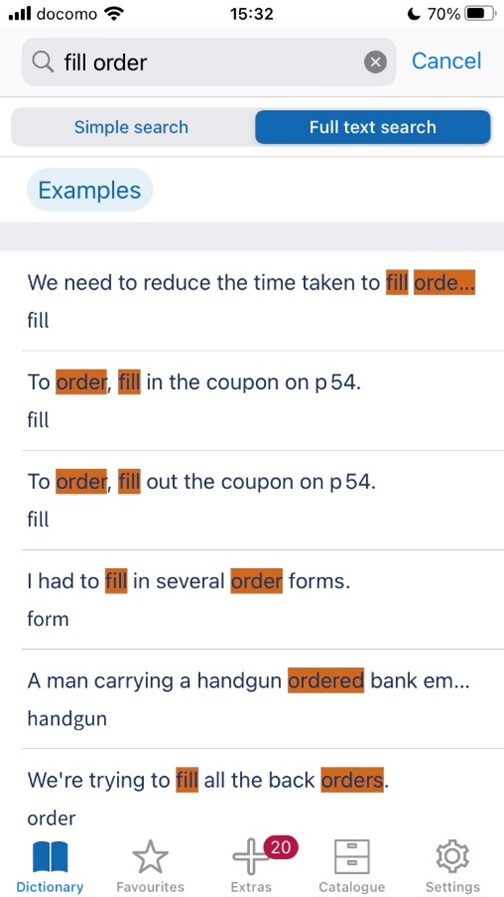
If you tap on the first example, which appears to be the most relevant, you can see that it corresponds to sense 12 of fill:

3. Improve your vocabulary with Full text search
Advanced users can also use Full text search to improve their English knowledge. Learners can search for the words and phrases they are interested in, and examine the example sentences to see how they are used, paying attention to meaning, nuance, collocation, and context. For example, if you look up end up, you will find that the phrasal verb has the following usage patterns:
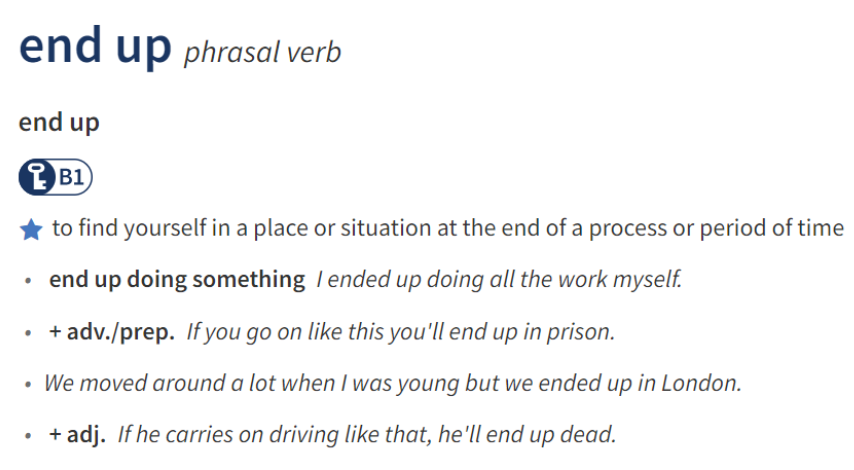
By conducting a Full text search for example sentences rather than just for headwords, you will find a greater variety of results from all dictionary texts:
・In end up doing something, not is placed before the ing form of the verb:
- For all their talk of equality, the boys ended up not doing any cooking. (s.v. talk noun 4, Extra Examples)
・End up can be followed by these adverbial and prepositional phrases:
- We got lost and ended up miles away from our intended destination. (destination, Extra Examples; intended 1)
- I usually end up with gravy down my shirt front. (front 1, Extra Examples; shirt front)
・When end up is followed by a noun, as is often added:
- Without education, these children will end up as factory fodder (= only able to work in a factory). (fodder 2)
- ‘Maybe you'll end up as a lawyer, like me.’ ‘God forbid!’ (God/Heaven forbid (that…))
- I started as a trainee and ended up a supervisor. (start verb 6, Extra Examples)
・End up can be used with the following set phrases:
- The scene with the elephant ended up on the cutting room floor (= was not included in the final version of the film). (s.v. cutting room)
- The firm ended up deep in debt. (deep 14)
- His attempts to arrange a party ended up as a comedy of errors (= he made so many mistakes it was funny). (s.v. error)
- The economy went into recession and taxpayers ended up footing the bill. Sound familiar (= does that sound familiar)? (s.v. sound verb 1)
OALD’s example sentences are not a corpus. However, they are a carefully screened collection of high-quality examples which illustrate the meaning of headwords. By scrolling or tapping, you can immediately check the definition of the word in the example sentence. You can also check the importance of words based on CEFR (Common European Frame of Reference) and OPAL (Oxford Phrasal Academic LexiconTM), amongst others. (For more information read my first article.) Idioms in example sentences are shown in bold and are often accompanied by notes. The ability to quickly look up meaning, grammar, and pronunciation all in one place is utterly invaluable.
In this series of four articles, I have written about the past and present of OALD, the differences between paper and digital versions, the functions of different media, the impact of digitization on information presentation and search, and hints for effective use. These are just some of the things I've been thinking about while researching English-English dictionaries for foreign learners and actually using OALD in my own learning and teaching. I hope that my blogs will help you become familiar with this wonderful resource, and that through the ideas I have introduced you will be able to use it even more effectively.
Notes:
1 With the introduction of defining vocabularies of about 3000 basic words (the Oxford 3000TM in the case of OALD) and full-sentence definitions, definitions in contemporary learner’s dictionaries have become much easier to understand (please see my first article). There is a useful video within the premium online resources called “Understanding dictionary definitions” which explains that the words below are frequently used in definitions and are useful not only for understanding definitions but also for describing things when you don’t know the exact word in English:
process, substance, instrument, act, organization, state, quality
2 In August 2022 many words of Korean origin, such as bibimbap, were added to OALD.
(https://www.oxfordlearnersdictionaries.com/wordlist/new_words)。
3 As the topic is Latte Macchiato, order here has a double meaning: ‘requirement’ and ‘request’.
Reference:
Yamada, Shigeru. 2014. Guide to the practical usage of English monolingual learners’ dictionaries: Effective ways of teaching dictionary use in the English class. Oxford University Press.
https://www.oupjapan.co.jp/sites/default/files/contents/catalogue/oald/media/oup_guide_to_dictionary_use_2014_e.pdf
- About the author -
Shigeru Yamada
Professor at Waseda University, Tokyo. He is on the editorial advisory board of Dictionaries: Journal of the Dictionary Society of North America. He was a Co-Editor-in-Chief of Lexicography: Journal of ASIALEX. His specialization is EFL and bilingual lexicography. His publications include “Monolingual Learners’ Dictionaries – Past and Future” (The Bloomsbury Handbook of Lexicography, 2nd ed., Ch. 11, 2022)
Flipped Learning With Let’s Go and the Gamerize Dictionary
What could you do if you came to class and your learners were already able to accurately spell and pronounce the target language of the lesson? I recently asked Let’s Go author Barbara Hoskins Sakamoto. Her response?
“The sky is the limit!”
She then proceeded to provide concrete examples of all the exciting things teachers could do to help learners use language in meaningful and authentic ways in order to “own the language” in Barabara’s words.
In this article, we will look at flipped learning and how it can help us use the Let’s Go Series as a springboard to motivating language activities that allow learners to use English for genuine communication.
What is flipped learning?
Flipped learning has in a sense been used in educational practice in Japan for many years under the name “yoshu” which translates as preview. Flipped learning is the process of having learners 'pre-study’ content for a lesson with the aim of minimizing the amount of direct instruction done in class and maximizing opportunities for active learning.
The Gamerize Dictionary
The Gamerize Dictionary is a gamified language learning app that allows students to practice with spelling, grammar and speaking following any curriculum content, including the Let’s Go series. Through a variety of games in the Gamerize Dictionary learners are given ample opportunities to practice listening, reading, writing and speaking directly related to their course content. Though traditional worksheets or workbook activities can be used for flipped learning, the Gamerize Dictionary has the following advantages:

| Worksheets | Gamerize Dictionary | |
|---|---|---|
| Feedback |
Learners receive delayed feedback on errors. This can be less effective for improving accuracy. |
Learners receive immediate feedback on accuracy. This helps improve accuracy and confidence. 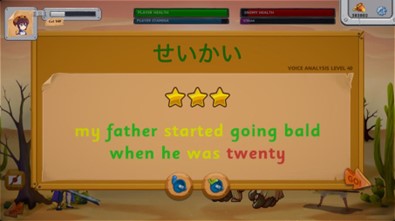 |
| Repetition & Recycling |
- 8 to 15 practice examples per page. |
- Up to 64 practice examples per 10 - 15 minute session  |
| Learner Needs |
- One worksheet assigned regardless of level. |
- Content for learners can easily be differentiated for different levels. 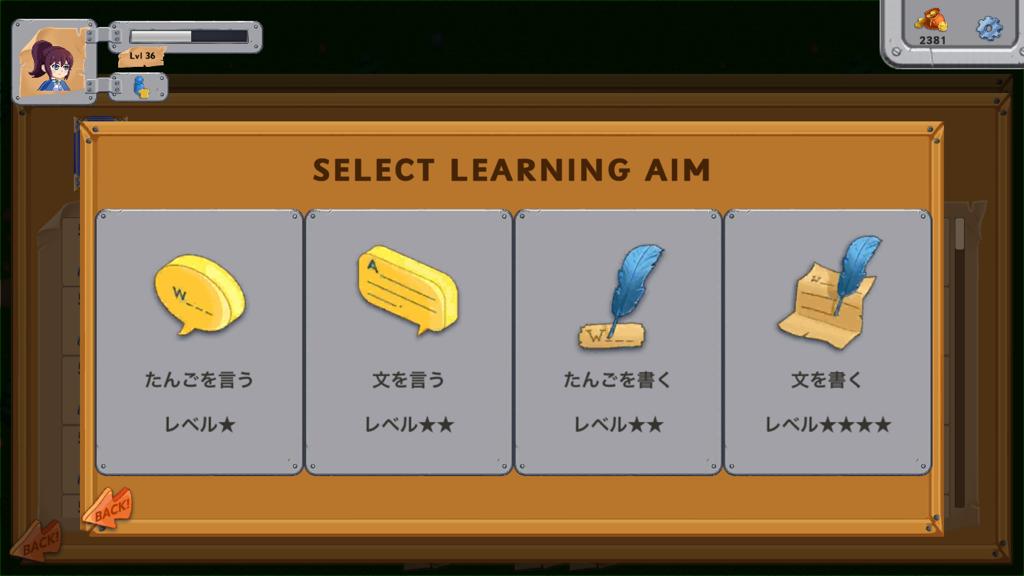 |
| Pronunciation |
- No feedback on pronunciation |
- Quick and accurate feedback on pronunciation. |
| Support & Scaffolding |
- Learners can use the accompanying textbook to access answers, but this often leads to copying answers which yields poor results in terms of retention. |
- Learners are able to access audio and written forms of the content before or after activities, helping them recall the information during games. |
| Spelling |
- Learners are able to practice writing answers by hand. |
- Learners are able to use a scaffolded keyboard to spell words but are not able to practice writing by hand. 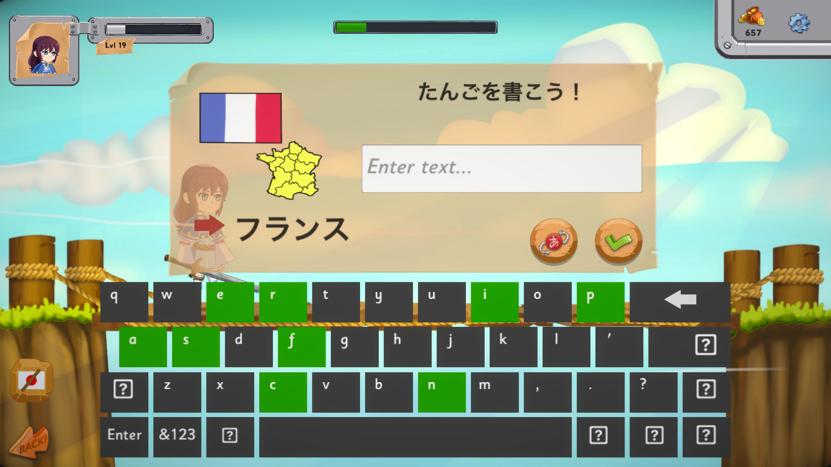 |
| Motivation |
- Some learners find worksheets to be a chore. |
- Minigames make practice fun. 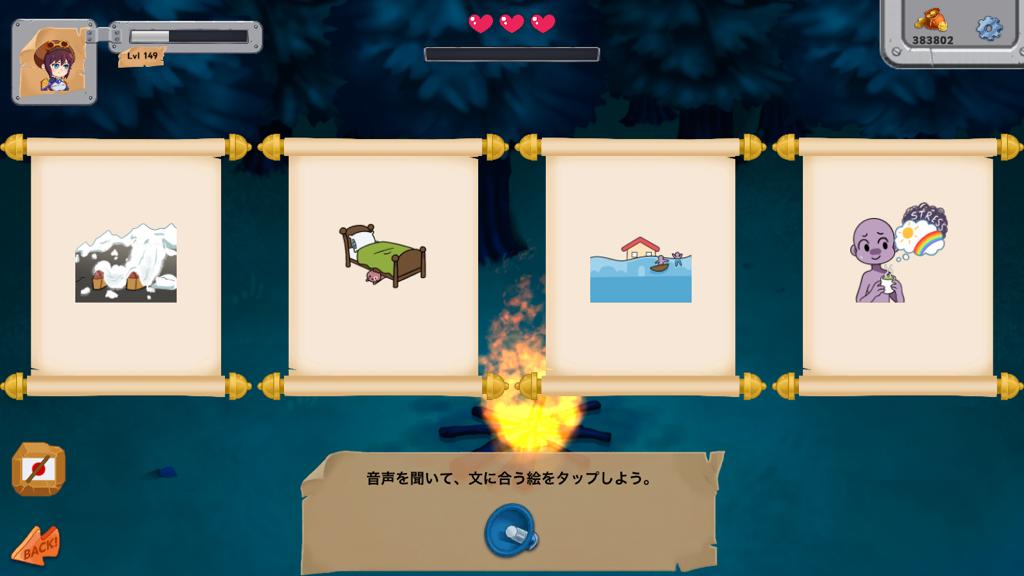 |
| Review |
- Let’s Go has a spiral syllabus with many opportunities to encounter recycled language. |
- Spaced repetition system ensures learners have enough review at the best timing to ensure retention and automaticity. 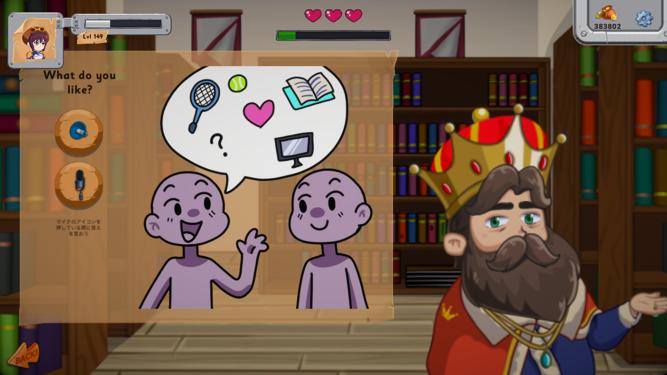 |
The Gamerize Dictionary ensures that learners can practice target language independently even before they have learned the content in class. Furthermore, they are able to repeat and review content receiving immediate feedback until they can confidently produce it on their own. This makes it ideal for flipped learning and making the most of limited class time.
The Sky's The Limit
Imagine you come to class and start introducing language for a new unit only to find that your learners are already proficient at producing the language orally and in written form. “Fantastic! Well my job is done here” you might think. Then again, you might also think “What am I going to do for the next 55 minutes?” With all of this extra time, one might be inclined to move on to the next unit or add another course book to your class. However, what this situation presents is an opportunity to take the next step in learning. Getting your learners to think and communicate using what they have studied.

Let’s Go 5th Edition Level 4
Flipped Lessons at Yellow Banana Academy
I joined Naoko Amano, owner of Yellow Banana Academy, veteran teacher and longtime user of Let’s Go to discuss some of the ways she uses Gamerize Dictionary and takes learning to the next level in her classes. Here are some of the ideas she shared with me.
Planning a Trip
In this lesson, the learners enjoy planning a trip of their choice and deciding on what to pack. The stages of the lesson are.
| Stage | Description |
|---|---|
|
Setting context and getting interest |
Watch videos about exciting travel destinations. This can be done with or without sound. Don’t treat this as a listening comprehension activity. 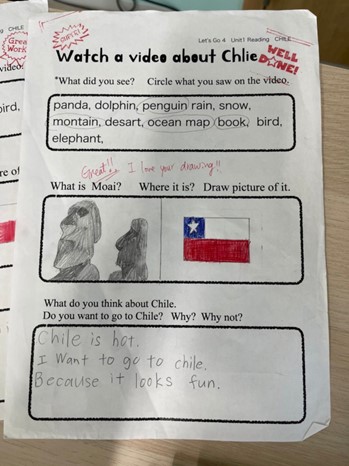 |
|
Task 1: Deciding on a destination & Activities |
The learners then: 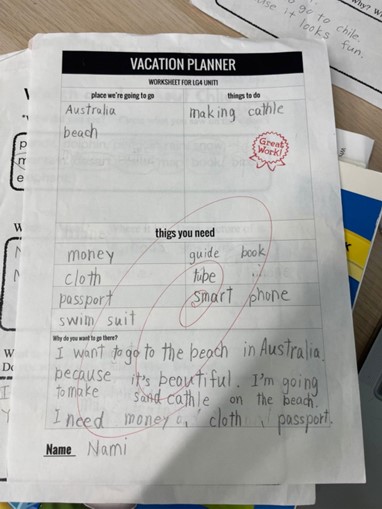 |
|
Task 2: Deciding on what to bring |
- Using the worksheet once again, the learners talk about what they need to bring on the trip and write down their list. |
|
Task 3: Presenting the plan |
- The learners face another group and present their plans to each other. The worksheet now acts as a prompt, again making the task more achievable. |
|
Task 4: Writing |
- The lesson is rounded off with the learners summarizing their plan in a short piece of writing. |
This lesson plan allows for varied interaction between students, multiple opportunities to use language from the course through different skills, personalization and also opportunities to fill in the gaps with new vocabulary that they need to execute the tasks. In this way, they are starting with familiar language that they have learned through Gamerize Dictionary, and this opens up more opportunities to learn language without feeling overwhelmed.
Ideas from the Author
When it comes to creative ideas for how to take lessons and to turn them into experiences that get students to push their limits and use English for communication, Let’s Go author Barbara Hoskins Sakamoto has no shortage of ideas. For her it is important for learners to have opportunities to say something meaningful to an audience. In other words, the learners should say something that they want to communicate to one or more people. This can be achieved in many ways and the following are some of her ideas for making the content come alive in the classroom.
Puppet Shows: Puppets are a great way to get learners to speak and take risks. Learners can use puppets to act out dialogues found in the Let’s Go and build on those with original input or create their own dialogues and act them out in a puppet show.
Making Books: Students can create their own storybook, gradually adding content at they go through a unit. For example, Barbara recalled one student who loved cats and during a unit on daily routines, the student created a cat as the main character in her storybook. She started by sequencing pictures of the cat's daily routine and making a basic outline and from there gave ideas about what the cat was doing. She then added extra detail extended the language, such as moving from “The cat takes a nap” to “The cat takes a nap on the bed”. Once this was complete the student presented the story.
Making Games: When learners play games with language that they are already confident with, they have more control of the game. They can negotiate the rules together or create new ways to play. This process is natural for children and an example of authentic communication, providing opportunities for them to talk about the game using language learned in the course, or building language beyond it as well.
Making Videos: Once learners have already developed a level of confidence with the target language in a unit, they can try creating videos. For example, after a unit on the weather, they can then create a weather report. To get the most communication out of a task like this, give students autonomy to control video equipment, decide roles, suggest props or gestures, start and stop recording and reviewing their work giving them a natural need to communicate.
Another great aspect of videos is that they can be shared for others to see, including parents, or even a school in another country!
Flip Your Classroom
Teachers and the classroom are valuable resources for learners, but there are things they can do on their own. If students only have a limited amount of time in class each week, why not let them use that time for the things they can only do in a classroom, not things they can do on their own? By cutting down on time spent on drilling grammar vocabulary and spelling we can make sure that our learners are making the best of their time in class and getting the genuine experience with using English.
Learn more about the Gamerize Dictionary here.
OALD: The Impact of Digitalization on Information Search
In this article, I would like to explore the impact of digitalization on how we use dictionaries to search for information. To highlight the strengths of the OALD’s digital search functions, I will focus on the following two points: Headword identification, the fourth of Hartmann’s 7 stages of dictionary searches1 (4 External search [macrostructure]) which has the most conspicuous influence from digitalization, and Full text search, an application which significantly increases the search range and flexibility.
Headword Identification
Thanks to digital technology, it is much easier to find the right headword. Functions such as incremental search, wildcard search, and voice input (the latter two only available on the app) allow us to search for words even without knowing the exact spelling. You can also see your search history when using the app2. Searching for idioms is also easy. For example, when searching for kick the bucket, you don’t need to worry about whether to search for kick or bucket. You can simply enter the entire idiom. Digital formats also make searching easier by displaying several candidate words and phrases. By the time you have entered kick t, kick the bucket has already appeared in the drop-down list. In the app version, by the time kick the has been entered into the search box, kick the bucket appears in the list of candidate phrases:
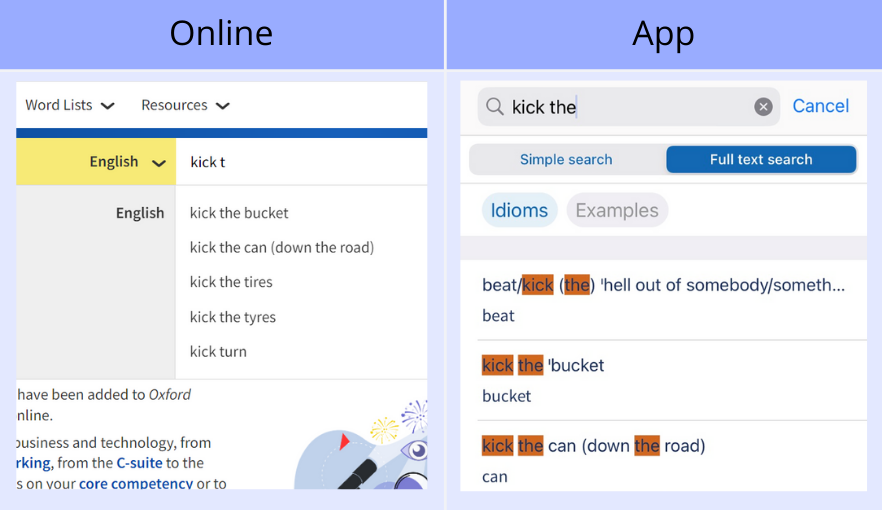
Incremental search has an educational value. For example, when searching for the phrasal verb fight out (which you can see in context in the excerpt below), just by typing fight, fight it out appears as a candidate phrase, teaching you that it is a set phrase.
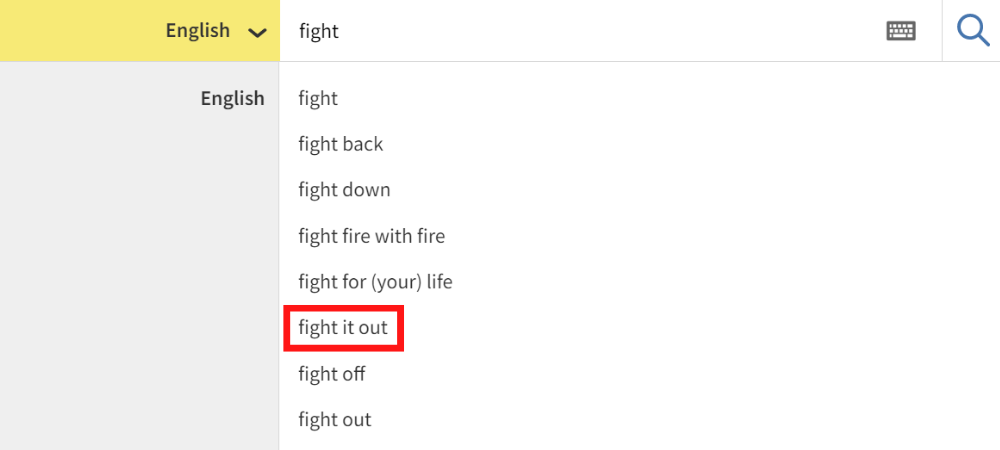
Quotation:
Considerant and Proudhon fight it out. The caption reads: “Proudhon and Considerant know very well that neither one can digest the other. Nonetheless each seeks to devour the other. … A strange social aberration!!” Cartoon by Bertall, Le journal pour rire, February 24, 1849, reprinted in Bêtisorama. Photo by Harvard University Library Reproduction Services. By permission of the Houghton Library, Harvard University.
Beecher, Jonathan. “Chapter 11 - June 13, 1849” Victor Considerant and the Rise and Fall of French Romantic Socialism, Part Ⅲ Revolution. (California: University of California Press, California Scholarship Online, 2001), pp.246-266.
(https://academic.oup.com/california-scholarship-online/book/35523/chapter/305721089?searchresult=1#305721219)

Full text search
Full text search allows you to search for headwords, idioms, and example sentences based on single or multiple key words. Notes attached to example sentences, extra examples, and other columns are also searchable3. This function also picks up words and phrases which are not headwords, idioms, and other subheadings, making searching on the app more comprehensive, more flexible, and complementary than the online version, which doesn’t allow such searches.
For example, if you search for eye contact using Simple search, it does not appear on the list of candidates, showing you that this is not a headword. If you search using Full text search, 8 example sentences appear:
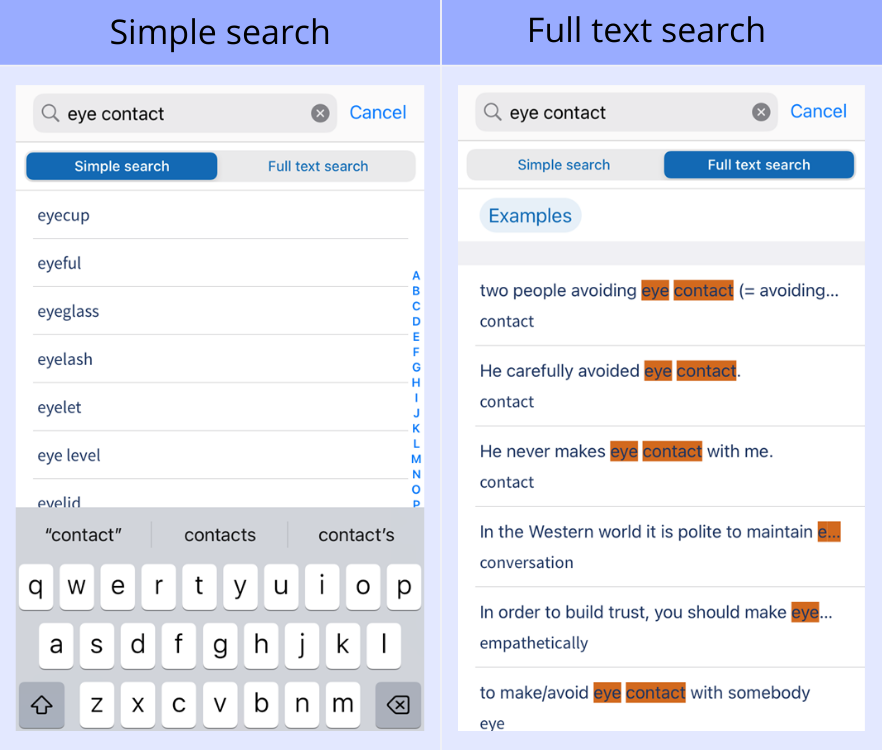
If we look closely, we can see that eye contact are written in bold type in the example sentences under the respective entries for contact and eye:


The conventional process for looking up words (headword → definition → example sentence)4 has been reversed here. This is something wonderful which cannot be done with a paper or online dictionary. As we can see from the 6 examples below, useful collocations, context, and cultural information are also provided:





Finally, I would like to look at 2 complementary ways of using Full text search. By “complementary search”, I mean ‘a search performed to supplement the description in the dictionary’. As we can see from the entry for weakness below, OALD traditionally uses forward slashes to save space and present several collocations:
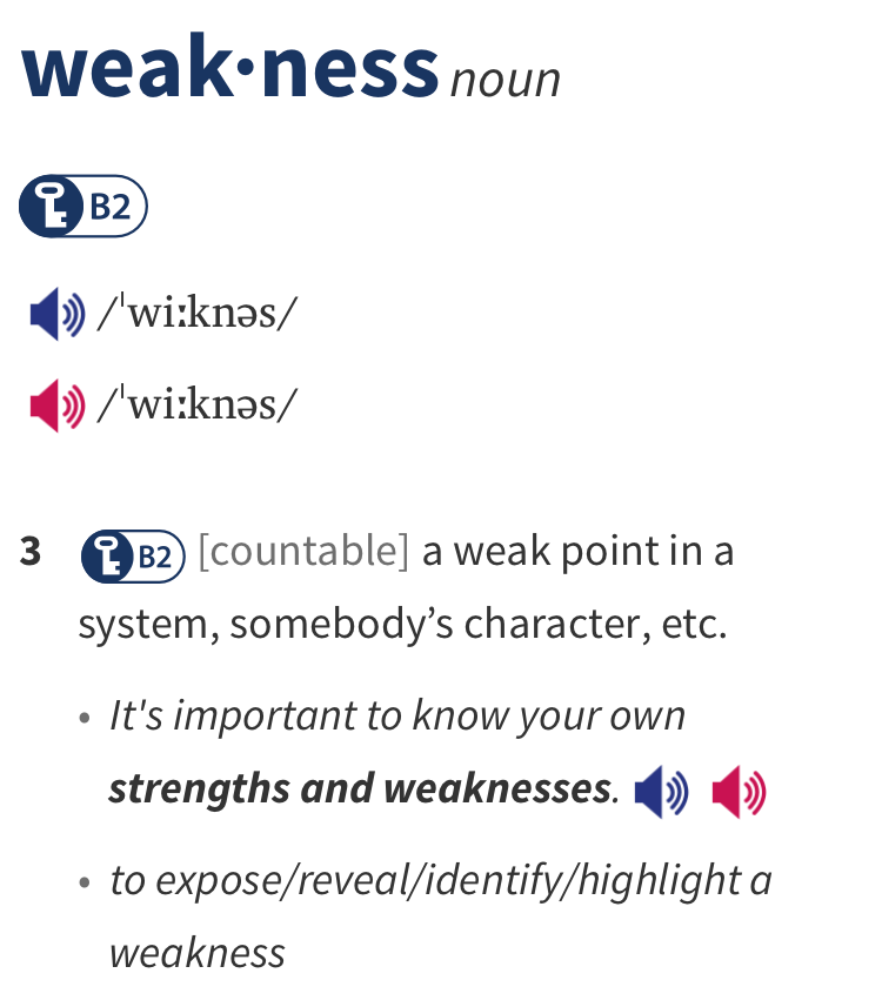
As an inquisitive student, you would like to know in what context each collocation is used. If you conduct Full text search using the keywords expose and weakness, reveal and weakness, etc., the search engine will search through OALD and display examples containing these words.
Some phrases have variations. The example below shows the following pattern:
down to + adjective (superlative, etc.) + noun
(In OALD, “etc.” shows that other options are possible6.):
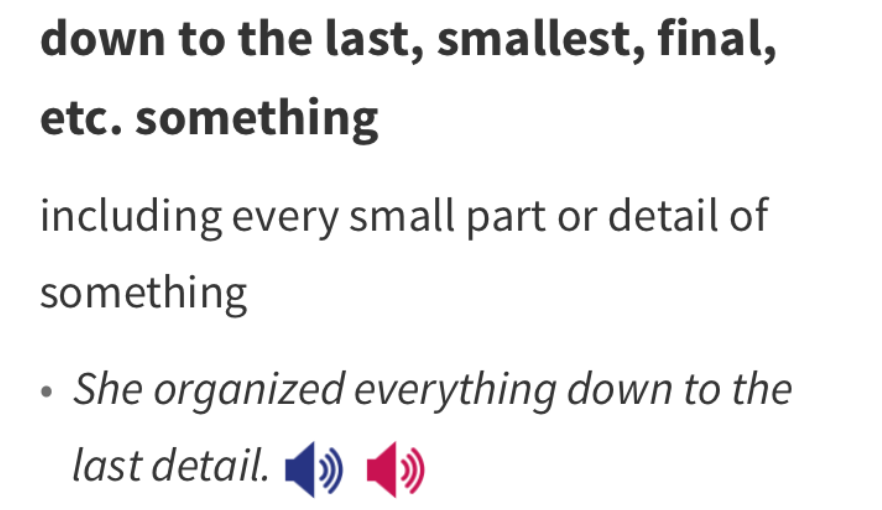
If you want to know what kind of adjectives and nouns this pattern is used with, try Full text search with the key words down to the. There were 7 hits and most of the examples contained … down to the last detail. 6 of the examples contained the verb plan. This showed a useful pattern containing the verb (plan … down to the last detail). There was also an example sentence containing down to the smallest …:
Everything had been planned down to the smallest detail.
A tap on the example takes you to the original entry, small (adjective, sense 5), teaching you the adjective is used in the sense of ‘slight, not important’:

Using Full text search and bringing examples sentences together in one place, certain things become clear. Tapping an example sentence brings up an entry for the source. You can deepen your understanding by checking definitions and other example sentences as appropriate.
Notes
1 Hartmann (2001: 89-92) abstracted dictionary lookup into seven steps. Although based on using a paper dictionary, it provides a useful model that applies to searches for both receptive and productive purposes. Researching information in a dictionary is complicated, requiring users to follow these steps to get to the correct answer:
- 1) Activity problem
- 2) Determining problem word
- 3) Selecting dictionary
- 4) External search (macrostructure)
- 5) Internal search (microstructure)
- 6) Extracting relevant data
- 7) Integrating information
2For information on which search functions are available in paper, online (free/premium), and app versions, see the table "Search" at the end of my previous article, "OALD: The Impact of Digitization on Information Presentation". Please refer to:
https://www.oupjapan.co.jp/en/kidsclub/articles/teachers/index.shtml#OALD_202211
3Etymology is not covered.
4Since the meaning of a word can be identified by using example sentences similar to the sentences being read, it is also possible to use this process for looking up words: headword → example sentence → meaning.
5There are 54 extra example sentences for conversation, and it's hard to find the ones that include eye contact. Without using Full text search, there is no way to know that example sentences containing eye contact exist.
6 Slots may be indicated by “…” without representative words shown (e.g., in terms of something | in … terms).
Reference:
Hartmann, R. R. K. 2001. Teaching and Researching Lexicography. Pearson Education.
Author Profile
YAMADA Shigeru
Professor at Waseda University, Tokyo. He is on the editorial advisory board of Dictionaries: Journal of the Dictionary Society of North America. He was a Co-Editor-in-Chief of Lexicography: Journal of ASIALEX. His specialization is EFL and bilingual lexicography. His publications include: “Monolingual Learners’ Dictionaries – Past and Future” (The Bloomsbury Handbook of Lexicography, 2nd ed., Ch. 11, 2022)
Guide to the practical usage of English monolingual learners’ dictionaries: Effective ways of teaching dictionary use in the English class (2014, Oxford University Press)
https://www.oupjapan.co.jp/sites/default/files/contents/catalogue/oald/media/oup_guide_to_dictionary_use_2014_e.pdf
OALD: The Impact of Digitalization on Information Presentation
Read Vol. 1
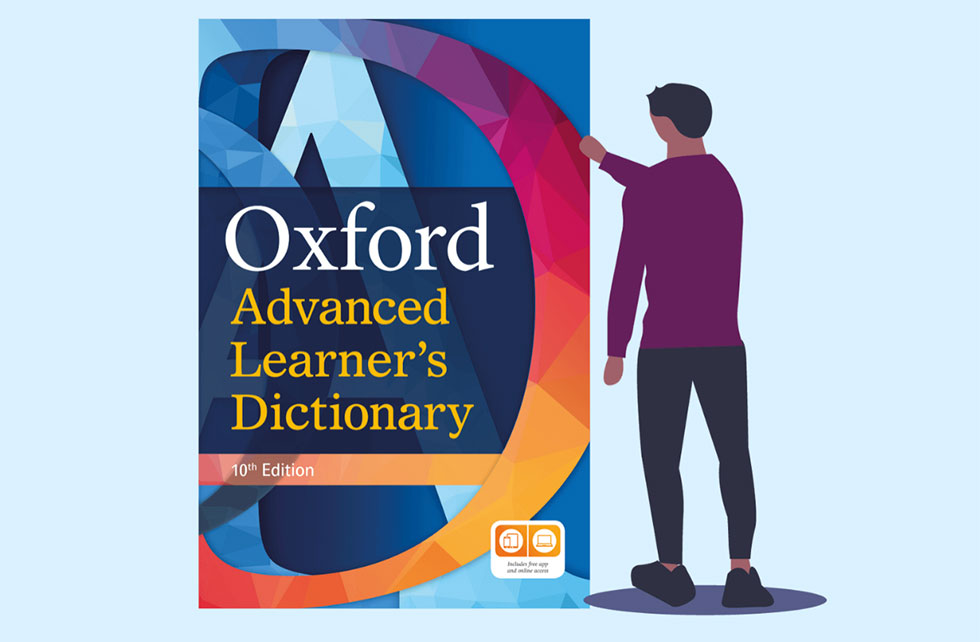
Dictionaries were once thought of only as a printed reference work. However, from around 1990, English dictionaries for learners became available on portable electronic devices, CD/DVD-ROMs, and the internet. These days, dictionary apps are easily accessible on smartphones. In this article, I will explore the impact of digitalization on how information is presented in dictionaries.
Let's compare the entries for the word acknowledge in the paper and online versions of the Oxford Advanced Learner's Dictionary 10th Edition (OALD10). Whereas the online version has a very clear layout, the print publication employs numerous symbols and abbreviations to maximize the limited space and enrich the content. Digitalization has granted designers greater space in which to present information in an easy-to-read format. Unlike the printed edition, the online version has line breaks for phonetic symbols, shortcuts, definitions, and individual examples. This creates more white space making it easier on the eyes.
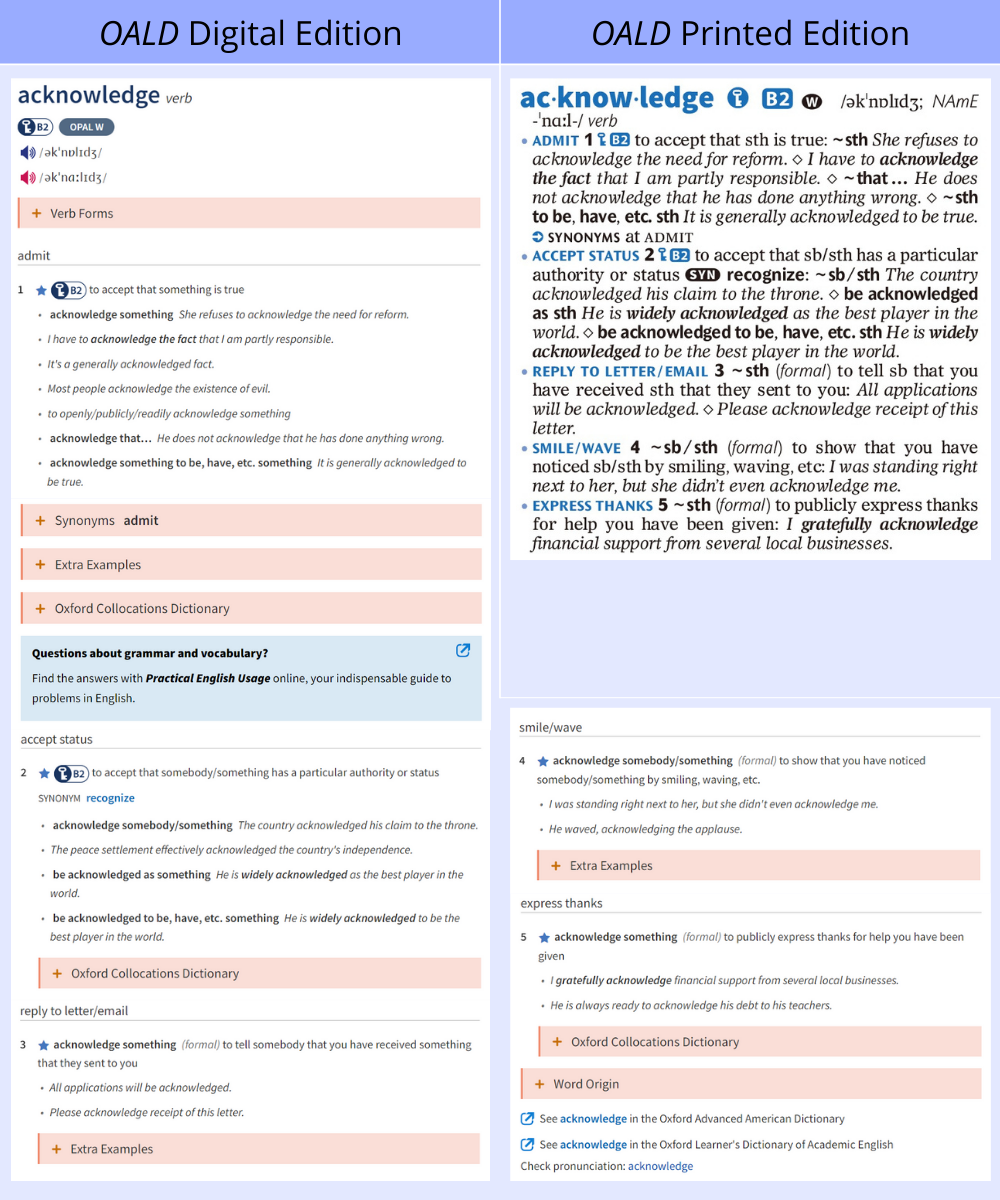
Furthermore, you will notice from the example below that some information is found only in the online dictionary. Here, users can click the plus sign to expand the text.
+ Verb Forms
+ Synonyms admit
+ Extra Examples
+ Oxford Collocations Dictionary
+ Word Origin
Let's take a closer look at the entry for acknowledge from the beginning. Online, users can click ![]() to view other items from the Oxford 3000 wordlist which are at B2 CEFR level in alphabetical order. When using the
to view other items from the Oxford 3000 wordlist which are at B2 CEFR level in alphabetical order. When using the ![]() function, a pull-down menu with Oxford 3000, Oxford 5000, and Oxford 5000 excluding Oxford 3000 appears, and words from levels A1 to C1 (multiple levels can be selected) can be displayed. Users can also
function, a pull-down menu with Oxford 3000, Oxford 5000, and Oxford 5000 excluding Oxford 3000 appears, and words from levels A1 to C1 (multiple levels can be selected) can be displayed. Users can also ![]() the following PDF lists:
the following PDF lists:
The Oxford 3000
The Oxford 3000 by CEFR level
The Oxford 5000
The Oxford 5000 by CEFR level
American Oxford 3000
American Oxford 3000 by CEFR level
American Oxford 5000
American Oxford 5000 by CEFR level
Clicking on a word on the screen list will open that word's entry. Users can hear the English or American pronunciation of that word by clicking on the blue ![]() or red
or red ![]() speaker icon. They can also search the displayed list by typing a word in the search box.
speaker icon. They can also search the displayed list by typing a word in the search box.
By clicking ![]() , users can view items from sublist 10 of the written words list in the Oxford Phrasal Academic Lexicon (OPAL). OPAL is a newly developed corpus-based list of important words in academic English from Oxford University Press. It consists of four lists: written words, spoken words, written phrases, and spoken phrases. The written words list has 1200 keywords in 12 sublists of 100 words each, and the spoken words list has 600 keywords in six sublists of 100 words each. Sublist 1 in each category contains the most important terms, followed by the most important terms in descending order. The list of phrases is organized by function. The written phrases list contains approximately 370 phrases in 15 functional sublists, and the spoken phrases list contains approximately 250 phrases in 16 functional sublists.
, users can view items from sublist 10 of the written words list in the Oxford Phrasal Academic Lexicon (OPAL). OPAL is a newly developed corpus-based list of important words in academic English from Oxford University Press. It consists of four lists: written words, spoken words, written phrases, and spoken phrases. The written words list has 1200 keywords in 12 sublists of 100 words each, and the spoken words list has 600 keywords in six sublists of 100 words each. Sublist 1 in each category contains the most important terms, followed by the most important terms in descending order. The list of phrases is organized by function. The written phrases list contains approximately 370 phrases in 15 functional sublists, and the spoken phrases list contains approximately 250 phrases in 16 functional sublists.
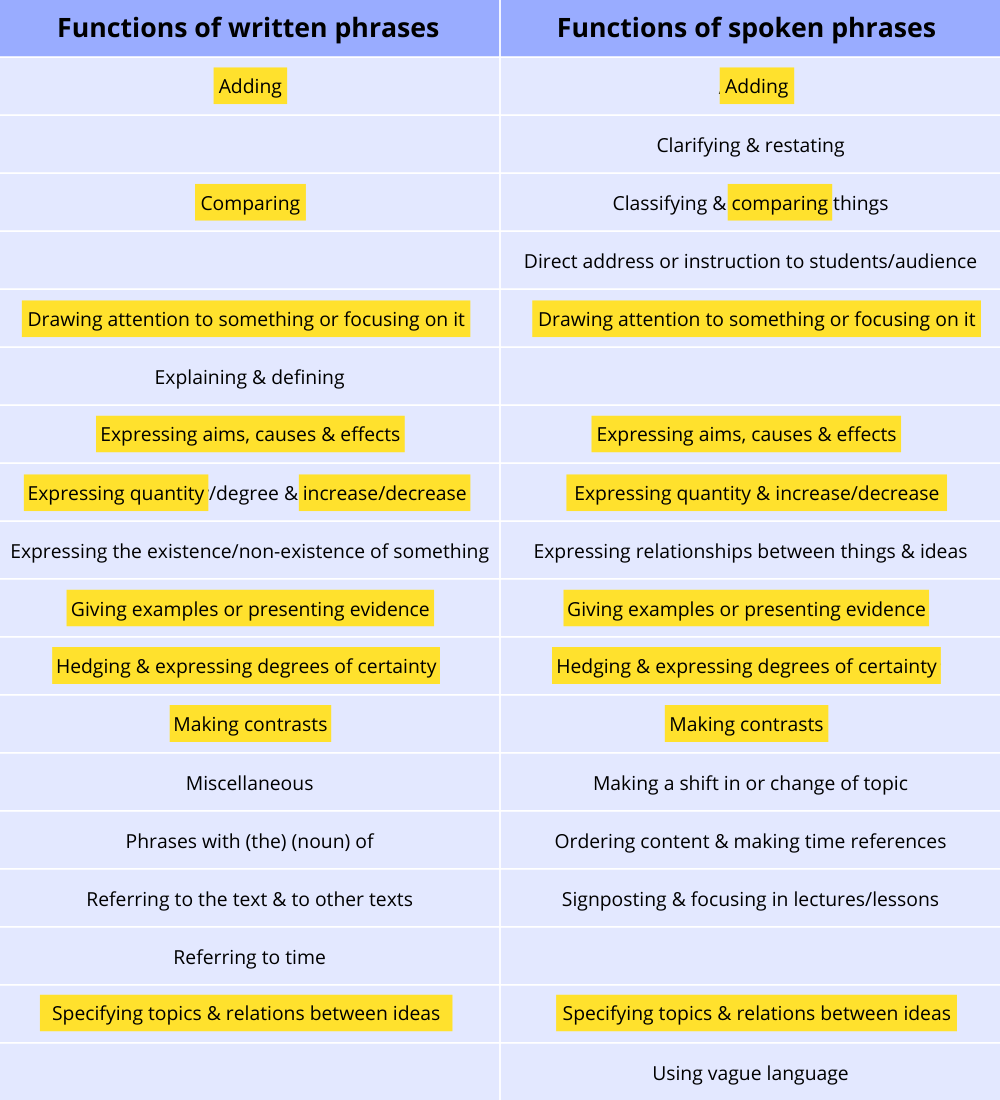
*Features common to written and spoken phrases are highlighted.
Clicking![]() will reveal the following pull-down menu, allowing users to filter by list (words by importance, and phrases by function) to display relevant words and phrases:
will reveal the following pull-down menu, allowing users to filter by list (words by importance, and phrases by function) to display relevant words and phrases:
Dictionary: Academic English/English
Word List: OPAL written phrases/ OPAL spoken words/OPAL written words/OPAL spoken phrases
The following PDF lists of key words in Academic English organized by sublists can be downloaded:
OPAL: written single words
OPAL: spoken single words
OPAL: written phrases
OPAL: spoken phrases
Let’s return to the main page for acknowledge. By clicking the blue and red speaker icons in front of the phonetic symbols, users can hear the English and American pronunciations. Also, as you can see from the pictures below, the print version uses symbols and abbreviations in bold type to show the example structures (~ represents acknowledge, sth is short for ‘something’, and sb for ‘somebody’), whereas they are fully written out in the digital version. In addition, sense 1 of the online version contains three examples not included in the print publication.
By looking at the entries for acknowledge, we can see that the online version is easy to read and contains a large amount of information. Additional information is organized into different sections in order not to sacrifice readability. In the print age, when space was precious, every effort was made to make maximum use of a limited space.
The OALD is currently available in print, online (for free), premium online, and the app (Google Play / App Store). The access code for the app and the premium online can be purchased with the print dictionary, and also the premium online access code can be purchased separately. OALD now goes beyond the traditional framework of a "dictionary" and provides guidelines for vocabulary learning, as well as comprehensive support resources for learning and teaching English. It also provides information, functions, tools, and materials that are useful not only for searching, but also for learning and teaching. I have listed the most important of these tools and where to find them under the following headings:
General information
Columns
Search
Appendices
How to use the dictionary
Others
I hope that the information in this article will help you to get the most out of the wonderful resources available with the OALD.
Reference:
Takahashi, Rumi, et al. 2021. “An Analysis of Oxford Advanced Learner’s Dictionary of Current English, Tenth Edition.” Lexicon. No. 51. Iwasaki Linguistic Circle. 1-106.
Usage guide:✓ = available, (✓) = partially available, X = unavailable, N.A. = not applicable. Locations are indicated below the symbols where appropriate.
NEW = introduced with OALD10 (2020).
●General information

●Columns
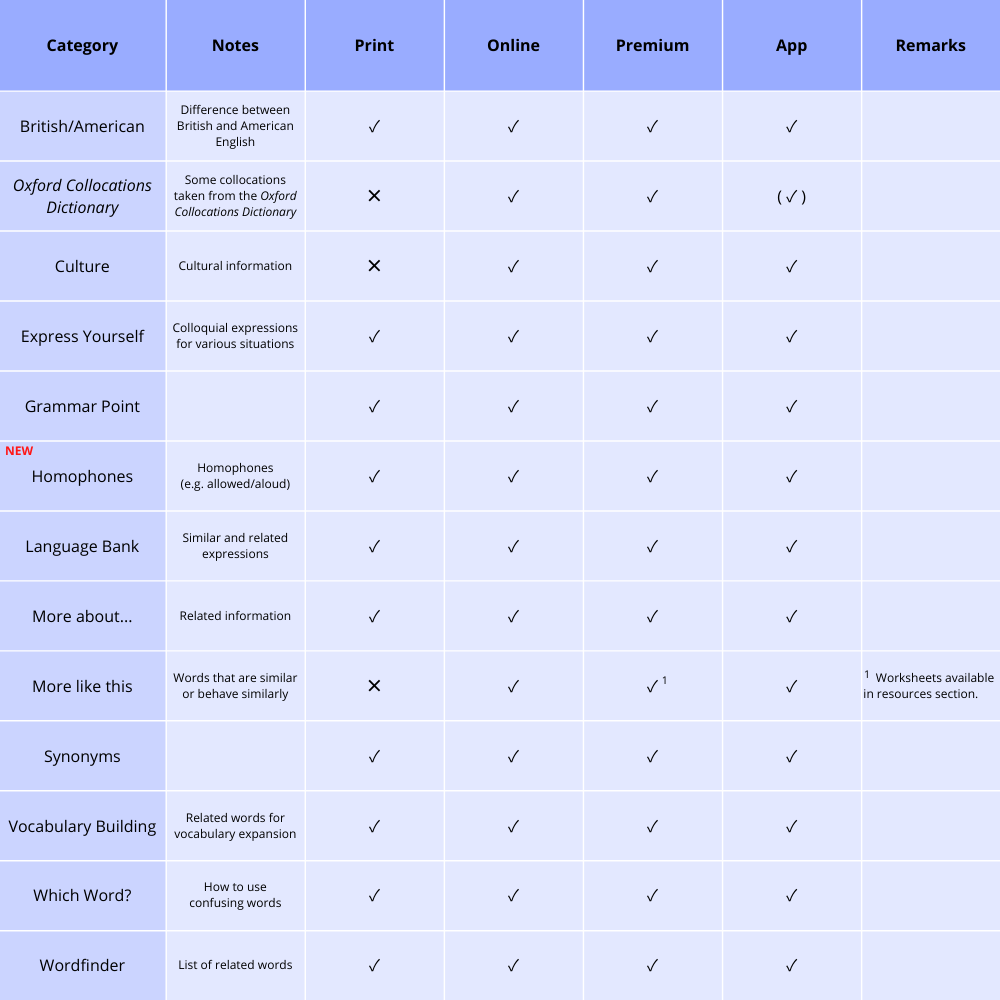
●Search

●Appendices
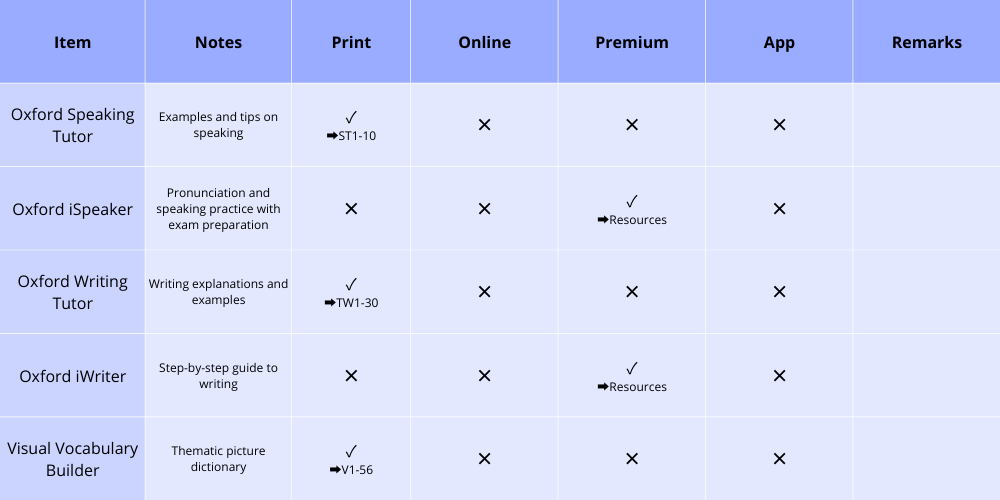
〇References (reference pages on the OALD Premium online)

●How to use the dictionary
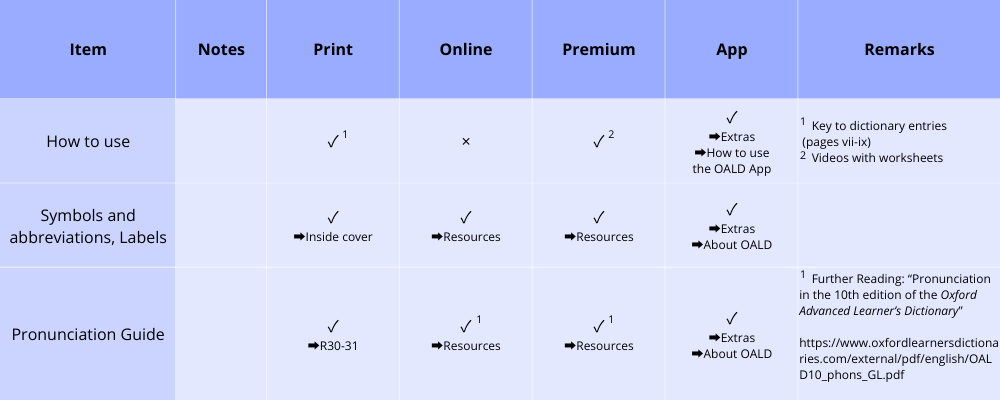
●Others
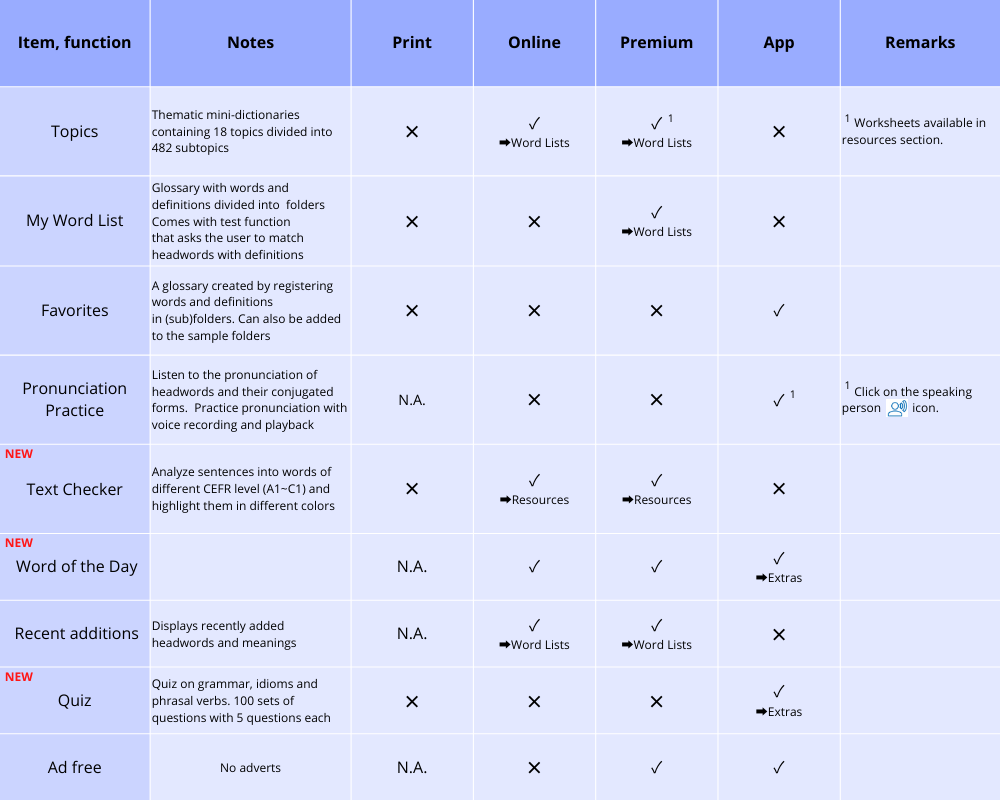
Author Profile
YAMADA Shigeru
Professor at Waseda University, Tokyo. He is on the editorial advisory board of Dictionaries: Journal of the Dictionary Society of North America. He was a Co-Editor-in-Chief of Lexicography: Journal of ASIALEX. His specialization is EFL and bilingual lexicography. His publications include: “Monolingual Learners’ Dictionaries – Past and Future” (The Bloomsbury Handbook of Lexicography, 2nd ed., Ch. 11, 2022)
Guide to the practical usage of English monolingual learners’ dictionaries: Effective ways of teaching dictionary use in the English class (2014, Oxford University Press)
https://www.oupjapan.co.jp/sites/default/files/contents/catalogue/oald/media/oup_guide_to_dictionary_use_2014_e.pdf
Using English-English Dictionaries in the Secondary Classroom Vol. 2
Read the first article.
One strategy I recommend to all teachers who want to make sure their students keep doing an activity inside and outside of the classroom: prioritize that activity and do it in every lesson without fail. For example, if your goal is for students to learn to read aloud, you must ensure students practice reading aloud in every lesson, or they will not do it at home. I believe this is also true for shadowing, listening, or any other exercise.
Teachers usually set homework assignments using physical items such as worksheets and notebooks, so it’s easy to check students’ work. But for tasks such as reading aloud, shadowing, listening, and looking words up in dictionaries, it’s more difficult to confirm whether or not students are actually doing them. In the past, I used a check sheet for reading aloud and had students submit it every week, but there was no way to know whether they were being honest. In other words, we have no choice but to believe our students. Often students would hand in meticulously written check sheets, but when I listened to them reading passages aloud, I was doubtful they had really practiced.
When I was younger, I often worried about whether my students would form genuine study habits if I entrusted them to work independently. I decided to carefully observe what my students worked diligently on in class and which homework activities they were enthusiastic about. This led me to an important discovery. Students work harder on things that they know they will be evaluated on. It's an obvious point, but one that I had completely overlooked. I then redesigned my classes to have a stronger emphasis on the exercises that I wanted students to practice every day. Once students had become confident with reading aloud, shadowing, and extensive reading in class, I could trust them to do those activities at home as too.
The same principle applies to using monolingual dictionaries in the classroom. That is, always refer to an English-English dictionary in every lesson, at any opportunity, and without exception.
I have been using English-English dictionaries in my lessons for 6 years, and I make sure that there is some time for dictionary work in every class. All my students have a copy of the Oxford Basic American Dictionary (Oxford University Press. Out of print and while stocks last), and we use it to look up words that appear in textbooks, vocabulary lists, reading and listening passages.
Every time students use a dictionary, they should also check the grammatical terms. If not, they forfeit half the benefit of using a dictionary. This practice helps them realize that the English grammar they learn in the classroom has its life outside in the real world.
Tip:Have students refer to their dictionaries and take notes during activities such as reading aloud, using textbooks, group discussions and active learning
When reading aloud or explaining the contents of textbooks, it’s best not to explain the meaning of words in Japanese or have students look them up an English-Japanese dictionary straight away. Instead, make students use an English-English dictionary and practice taking notes. We should put aside any fear that students may not understand definitions in English. In second language acquisition, worrying too much about learners can hinder acquisition.
When I ask my students to look up words in an English-English dictionary, they react completely differently to how I would expect. They go ahead and look up the word without any complaints at all. When I tell them to look at the English sentences and think about the meaning with their friends, they will start guessing the meaning in pairs or groups. After that, I provide simple explanations such as, “If you take the first part of this sentence it will make this …”, and then give further instructions. Doing this is very important.

Just looking up one word isn’t enough for effective learning. It is important to repeat the same activity for the sake of continuity and to develop long-term learning habits.
I often ask my students what they think the other parts of speech for a word will be and then to check, then look up another word. They quickly get the point and feel satisfied.
I repeat this activity by changing the parts of speech that students look up in the dictionary in each lesson, such as nouns, verbs, adjectives, adverbs, and articles. After repeating this for about two weeks, they will become accustomed to looking up words in English-English dictionaries without difficulty. Let’s look at an example. If you look up the verb “go”, you will find the definition, “to move or travel from one place to another.” I explain each part of the definition in Japanese from the beginning. Next, I ask students to look up the verb, “come”. They will find the definition, “to move to or towards a person or place.” Again, I explain each part of the definition in Japanese.
Students can recognize two points about English grammar here: the verb is explained with “to do", and the preposition shows the direction. Even if I don't make full use of grammatical terms in detail, I can touch on many grammatical items just by explaining the meaning of words in an English-English dictionary. You can naturally understand how sentences are generated and how grammatical meanings are formed. I then repeat this for the other parts of speech.
I taught the meaning of the infinitive “to do” to my first-year junior high school students before covering it in grammar class. To illustrate, the Oxford Reading Tree Dictionarydefines the word “address”as, “Your address is the place where you live.” I used this definition with my first-year students without touching on the grammar, and it worked very well. Beginner-level English learners in their first year of junior high school cannot yet understand detailed grammar such as noun clauses, so at this stage, it’s enough for them just to read and comprehend the overall meaning. Later, when the teacher explains the grammar, students will realize how the English language is structured. It’s important to take students through the steps: familiarity, habituation, use, and grammar comprehension. This process simulates how young children learn languages.
Introducing some of these changes may feel troublesome at first, but by being consistent and using these techniques in every class, students will quickly get used to them and develop positive learning habits. When I was a high school student, we always used an English-Japanese dictionary for classroom activities and homework and this just became a natural part of studying. The same is also true when the teacher asks their students to use an English-English dictionary in every lesson.
As we have seen, there are many benefits to using English-English dictionaries. I hope that the ideas in this article help you move away from translation toward all-English study; providing students with the skills they need for effective language learning.
Special interview with characters from Oxford Reading Tree: Learning at home with Oxford Reading Tree
~For anyone currently using or thinking about using Oxford Reading Tree~
今回は森藤ゆかりさん(ビコさん)をゲストにお招きしてOxford Reading Tree (以下ORT)を使用した子育て方法について対談形式でお伺いいたしました。
① これからORTを使おうとしている方に向けて

A: 息子が4歳の時、初めて本屋さんで「買って」と持ってきた絵本がORTでした。タイトルは”The Toys' Party”です。
我が家では息子が1歳前から少しずつ英語のCDを聞かせていたのですが、いずれは読書できるようにしてあげたい、と思っていたので、ORTを見て「これは、息子にちょうどいい」と感じました。薄手の絵本パックで量があり、内容も理解しやすく、何より子ども(キッパー)が生き生きと描かれていることに温かみが感じられて、とても気に入りました。

A: ………続く
対談記事全文ではORTのキャラクターたちが登場しビコさんにお話をお伺いしています。こちら よりお読みいただけます。

森藤 ゆかり(ビコさん)
自身の子育てを機に、英語子育てサイトR-Train開設。以後20年以上、コミュニティやメディアで英語や家庭教育について情報発信を続けている。
息子は、バイリンガルに育ち東京大学へ。
著書「+(プラス)えいごではなまる子育て」、絵本の活用法など多数。
Oxford Advanced Learner’s Dictionary: Now and then
In 2020, the 10th edition of the Oxford Advanced Learner’s Dictionary, or OALD, was published. The origin of this dictionary can be traced back to the Idiomatic and Syntactic English Dictionary (ISED), the world's first fully-fledged English-English dictionary for English language learners. ISED was edited by A. S. Hornby and others, who were invited from the United Kingdom to engage in English education in Japan, and was published by Kaitakusha in 1942. 2022 marked the 80th anniversary of the ISED. During that time, as English was established as the international language of communication, the rivalry between different publishers has, together with the development of (applied) linguistics and lexicography, contributed to the ongoing evolution of monolingual dictionaries for language learners.
Since the mid-1990s, the quality of information has improved, and monolingual dictionaries have become easier to use. The key concepts are “corpus basis” and “user-friendliness”. To appreciate what kinds of changes have occurred, let's compare the entries of acknowledge in the 4th edition (1989) and the 10th edition (2020) of OALD.
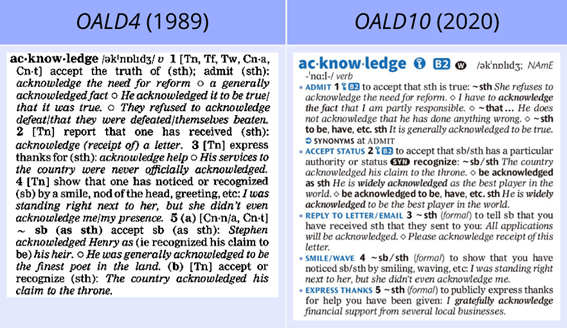
Firstly, compared to the 4th edition, the 10th edition is easier to read; it is printed in two colors with each definition written on a new line. The OALD has been printed in two colors since the 6th edition (2000). Furthermore, in the 10th edition, notice these symbols next to the headword:  ,
,  , and
, and  . What do these symbols represent?
. What do these symbols represent?
The Oxford 3000TM and The Oxford 5000TM
The key symbol (  ) indicates that the word is from the Oxford 3000 wordlist. This is a list of 3000 words that students of English should learn first, and was introduced in the 7th edition (2005) and revised for the 10th edition. The words have been selected based on frequency and relevance for the user. Frequency of use is determined by the Oxford English Corpus (which contains more than 2 billion words), and relevance by a specially created corpus of secondary and adult English courses published by Oxford University Press. Also, every definition in the OALD is written using words from the Oxford 3000, making the definitions easier to understand.
) indicates that the word is from the Oxford 3000 wordlist. This is a list of 3000 words that students of English should learn first, and was introduced in the 7th edition (2005) and revised for the 10th edition. The words have been selected based on frequency and relevance for the user. Frequency of use is determined by the Oxford English Corpus (which contains more than 2 billion words), and relevance by a specially created corpus of secondary and adult English courses published by Oxford University Press. Also, every definition in the OALD is written using words from the Oxford 3000, making the definitions easier to understand.
The key symbol with a plus sign (  ) refers to words from the Oxford 5000, which was introduced in the 10th edition. This introduces an extra 2000 words for higher-level students to learn. The key symbols for the Oxford 3000 and 5000 are not just added to the headwords but also to the definitions.
) refers to words from the Oxford 5000, which was introduced in the 10th edition. This introduces an extra 2000 words for higher-level students to learn. The key symbols for the Oxford 3000 and 5000 are not just added to the headwords but also to the definitions.
*Find out more about the Oxford 3000TM and the Oxford 5000TM wordlists.
https://www.oxfordlearnersdictionaries.com/wordlists/oxford3000-5000
Common European Frame of Reference (CEFR)
The Common European Frame of Reference divides foreign language competencies into six levels – A1, A2, B1, B2, C1, and C2. Words from the Oxford 3000 are labeled  -
-  , and words from the Oxford 5000 are
, and words from the Oxford 5000 are  or
or  .
.
The Oxford Phrasal Academic LexiconTM (OPAL)
 is an abbreviation for written, indicating that acknowledge is an important word in written academic English. Academic English is crucial for most users of the OALD, particularly those studying abroad or taking classes in English. Oxford University Press created The Oxford Phrasal Academic Lexicon (OPAL) from an analysis of two corpuses: Oxford Corpus of Academic English (which contains 71 million words) and British Academic Spoken English (which contains 1.2 million words). OPAL includes important words and phrases from both written and spoken academic English. In OALD10, words and phrases from the written academic English section of OPAL are signified by
is an abbreviation for written, indicating that acknowledge is an important word in written academic English. Academic English is crucial for most users of the OALD, particularly those studying abroad or taking classes in English. Oxford University Press created The Oxford Phrasal Academic Lexicon (OPAL) from an analysis of two corpuses: Oxford Corpus of Academic English (which contains 71 million words) and British Academic Spoken English (which contains 1.2 million words). OPAL includes important words and phrases from both written and spoken academic English. In OALD10, words and phrases from the written academic English section of OPAL are signified by  , and words and phrases from the spoken academic English section by
, and words and phrases from the spoken academic English section by  . Words that are used in both written and spoken English are marked
. Words that are used in both written and spoken English are marked  .
.
*Find out more about OPAL.
https://www.oxfordlearnersdictionaries.com/wordlists/opal
Grammar notation
Turning our attention to the 4th edition, we can see the first meaning of acknowledge contains these codes [Tn, Tf, Tw, Ca·n, Cn·t]. They indicate verb patterns. For example, [Tn] means transitive verb. Considering that this pattern was denoted by [VP6A] in the 3rd edition (1974), this is much easier to understand. Although a list of verb types could be found on the inside back cover of the 4th edition, referring to this each time was a real hassle. Though it takes up space, the grammar code is spelled out in the 10th edition (sb stands for somebody, and sth stands for something). In OALD10, these abbreviations, called “verb frames”, are written just before the corresponding example. The verb patterns and example sentences in OALD4 and OALD10 are summarized in the comparison table below. The clarity of the 10th edition is self-explanatory.
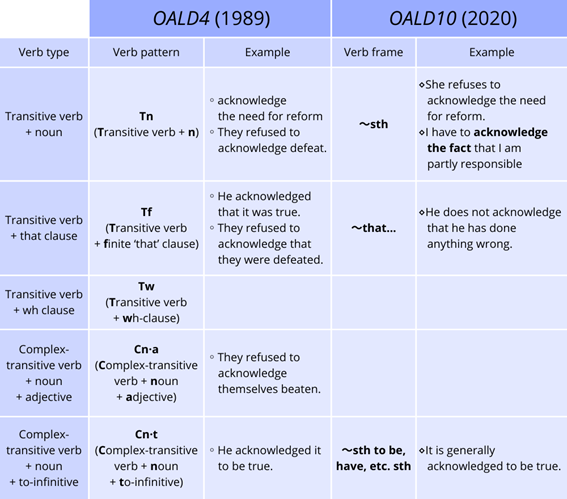
Shortcuts
Returning to OALD10, you’ll notice that each definition is preceded by a word or short phrase capitalized in blue and marked by a dot such as  . These are called “shortcuts”, and they show the context or general meaning of each definition at a glance. When using a monolingual dictionary, selecting the appropriate meaning can be a daunting task. Therefore, from the 6th edition (2000) on, "shortcuts" or "subheadings of meaning" were introduced to help users navigate polysemous entries. Instead of scrutinizing definitions and examples one by one, users can quickly scan the shortcuts, select the relevant one, and then examine the meaning.
. These are called “shortcuts”, and they show the context or general meaning of each definition at a glance. When using a monolingual dictionary, selecting the appropriate meaning can be a daunting task. Therefore, from the 6th edition (2000) on, "shortcuts" or "subheadings of meaning" were introduced to help users navigate polysemous entries. Instead of scrutinizing definitions and examples one by one, users can quickly scan the shortcuts, select the relevant one, and then examine the meaning.
The influence of corpuses
Since the introduction of the Collins COBUILD English Language Dictionary in 1987, the use of corpuses has become an integral part of dictionary editing. Corpuses provide vital data on the frequency of usage for each word, and this influences every stage of lexicographic editing from identification and selection of headwords, through sense division and arrangement, identification of grammatical and lexical patterns, to the presentation of examples. Let's look at how the entries of acknowledge are structured in OALD4 and OALD10. There are differences between the two, and the latter is based on frequency from corpus analysis.
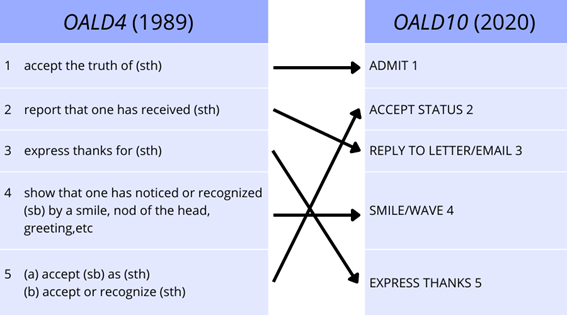
As you can see from the comparison table above, the verb types Tw and Cn·t shown in OALD4 are not included in OALD10. Based on corpus analysis, the frequency may not have been high enough. Frequent patterns such as acknowledge the fact are highlighted in bold in the examples.
The most recent editions of English-English dictionaries contain accurate information, presented in a format which is easy to understand and use. OALD10 has been edited based on large corpuses and displays the most high-frequency words. Innovations, such as the integration of the Oxford 3000 and 5000 wordlists and OPAL, make it easier for users to identify core vocabulary, the Oxford 3000 also making definitions easier to understand. In addition, shortcuts and straightforward abbreviations of verb patterns make the latest edition even more user-friendly. Whilst in the past dictionaries were only available in print, now it’s easy to find online versions. In my next article, I will explore the effects of digitalization on dictionaries, particularly on the editorial processes and how people search for words.
Reference:
Yamada, Shigeru. 2020. OALD10 Katsuyo Gaido [Usage Guide]. Tokyo: Obunsha Publishing.
https://dic.obunsha.co.jp/oald10/dl_guide_book/OALD10_dic.pdf
Author Profile
YAMADA Shigeru
Professor at Waseda University, Tokyo. He is on the editorial advisory board of Dictionaries: Journal of the Dictionary Society of North America. He was a Co-Editor-in-Chief of Lexicography: Journal of ASIALEX. His specialization is EFL and bilingual lexicography. His recent publications include “Monolingual Learners’ Dictionaries – Past and Future” (The Bloomsbury Handbook of Lexicography, 2nd ed., Ch. 11, 2022).
Using English-English Dictionaries in the Secondary Classroom Vol.1
The ability to understand English without translating into Japanese is something that many Japanese learners of English dream of achieving. I know this because I often hear students remark, “I wish I could understand English movies without subtitles.”
When I was teaching English at high school, there was a moment when I switched from giving instructions in Japanese to only speaking English during classes, often referred to as “all English” learning. At first, the students and I felt unsure about this new approach, but we pressed on and hoped for the best, trying different approaches together and developing our lessons.
During speaking activities, I was concerned whether students who struggled with simple things such as explaining something or describing a scene in English would be able to express their opinions freely or react to other people’s opinions.
Once, while preparing for a lesson, I happened to glance at the bookshelf and caught sight of some old books I rarely used. Among them was my copy of the Oxford Advanced Learner’s Dictionary. Flicking through it, I felt nostalgic upon finding words that I had underlined sometime ago. I decided to look up sushi, and found this definition: “sushi / noun / a Japanese dish of small cakes of cold cooked rice, flavored with vinegar and served with raw fish, etc. on top.”
Reading the definition reminded me of how you can use English to describe words such as sushi. It also brought to mind a segment from the television show Sesame Street in which adults explained new words to children.
I was worried about how my students would react if I introduced a new section to our class for using English-English dictionaries. As a student, I only studied with an English-Japanese dictionary: my teacher never recommended using an English-English dictionary, and I believed that only very high-level students would be able to understand definitions in English.
However, I soon realized there was no reason to worry, From the next lesson, I started getting students to use English-English dictionaries to make notes of definitions and explain words to each other in English during class. The students were not worried about the lack of Japanese translation, and they enjoyed reading the definitions in pairs and groups while working out the meaning of words together.

After about two years, I began to notice a change in my students’ written work. I used to have to spend a lot of time correcting and explaining the differences between Japanese and English syntax, but now there were far fewer mistakes. Also, when correcting their own work, more and more students would show me example sentences from their dictionaries and ask whether they should write sections of their compositions in a similar way. I remember how amazed and delighted I was by that change.
I used English-English dictionaries with my high school students for three years and felt strongly that this approach had many benefits. The next year, I was in charge of my junior high school’s first-year class and I recommended trying an all-English approach to my teaching partner. We invested in some picture dictionaries for the students, and used reading, listening and recitation activities, which encouraged students to understand English without translating. Three years have passed, and these students are now in the first year of high school. Each student has a mini English-English dictionary which they use during and outside of class, and it’s clear to me that the dictionaries have been very effective.
One of the benefits of using English-English dictionaries is that it encourages students to understand English without translating into Japanese. Of course, when learning new vocabulary it’s useful to know the Japanese translation, but understanding the meaning of English words in English helps learners to more naturally grasp grammatical rules as well.
In my next article, I will share some more of my experiences using English-English dictionaries.
Global skills for the primary EFL classroom in Japan
I began teaching English in Japan in October 2000. It’s strange to think that the elementary school children who I taught at the time are now adults, navigating life in the 2020s with all the challenges and opportunities of a global, technological society. Back in the early 2000s, I had no idea how life would change in the next 20 years and what skills or knowledge would be important for the future. I didn’t even own a mobile phone!
As the 21st century progresses, children increasingly need to receive an education which prepares them to deal with change and equips them with the skills needed for success in a fast-changing world. In our position paper on Global Skills, we identified 5 distinct clusters of skills essential for today’s learner: communication and collaboration; creativity and critical thinking; emotional self-regulation and wellbeing; digital literacies; and intercultural competence and citizenship. These skills are vital for students of all ages in their general education, and English classes provide a wonderful opportunity for children to develop these competencies from an early age. In this article, I will consider how 2 of the clusters (communication and collaboration and emotional regulation and wellbeing) can be applied to EFL classes for primary students in Japan.
Communication and collaboration
 Students in primary EFL classes in language schools in Japan tend to study in relatively small groups. Typically, the majority of communication in English takes place between the teacher and students, with the teacher asking questions and the students answering. For example, when studying the question-and-answer pattern, “What’s your favorite (sport)?”, “I like (tennis).”, it is common for the teacher to ask the question to each student individually and the students to give their own answers. There is nothing wrong with this approach, but to foster genuine communication and collaboration skills, we need to encourage students to speak English to each other, perhaps in pairs or groups, and work together to achieve common goals. Depending on the task, we could even have students decide which roles they each take in order to complete it.
Students in primary EFL classes in language schools in Japan tend to study in relatively small groups. Typically, the majority of communication in English takes place between the teacher and students, with the teacher asking questions and the students answering. For example, when studying the question-and-answer pattern, “What’s your favorite (sport)?”, “I like (tennis).”, it is common for the teacher to ask the question to each student individually and the students to give their own answers. There is nothing wrong with this approach, but to foster genuine communication and collaboration skills, we need to encourage students to speak English to each other, perhaps in pairs or groups, and work together to achieve common goals. Depending on the task, we could even have students decide which roles they each take in order to complete it.
Here are some ideas for increasing communication and collaboration in the classroom.
・Teach students both the question and answer forms, and have them practice asking and answering questions in pairs. Although children can be reluctant to speak English to each other at first, with enough practice they will become more comfortable communicating with their classmates in English. Younger children in particular will need an activity to structure their conversation. For example, you could give each pair a set of small cards, have them turn their cards face down and mix them around. Students then challenge each other by pointing at a card and asking, “What’s this?”
 ・Set your students a project. Projects are a great way to get students working together. For example, put students into groups and ask each group to make a poster about healthy food. To complete the task, the children must first decide together which kinds of food to include (to make it easier, you could limit the number of choices and give a specific target such as 5 kinds of food). Members will need to discuss and agree on who in the group does what: Who will draw pictures of the food? Who will write the names of the food under each picture? Who will write the title? Who will add glitter or other decorations? Finally, each group gives a short presentation about their poster, again deciding who will talk about each food. Throughout the process, there may be children who want to do everything themselves and others who are reluctant to get involved in the activity, but by carefully structuring the task, setting clear goals, and monitoring the activity, the teacher can ensure that the children are learning how to work together to accomplish a task and contribute equally. Students naturally need to communicate with each other to make decisions, and classroom phrases are very useful to ensure that plenty of English gets spoken. In this case, we might want to teach, “Let’s draw (broccoli)”, “I’ll (write the title)”, etc.
・Set your students a project. Projects are a great way to get students working together. For example, put students into groups and ask each group to make a poster about healthy food. To complete the task, the children must first decide together which kinds of food to include (to make it easier, you could limit the number of choices and give a specific target such as 5 kinds of food). Members will need to discuss and agree on who in the group does what: Who will draw pictures of the food? Who will write the names of the food under each picture? Who will write the title? Who will add glitter or other decorations? Finally, each group gives a short presentation about their poster, again deciding who will talk about each food. Throughout the process, there may be children who want to do everything themselves and others who are reluctant to get involved in the activity, but by carefully structuring the task, setting clear goals, and monitoring the activity, the teacher can ensure that the children are learning how to work together to accomplish a task and contribute equally. Students naturally need to communicate with each other to make decisions, and classroom phrases are very useful to ensure that plenty of English gets spoken. In this case, we might want to teach, “Let’s draw (broccoli)”, “I’ll (write the title)”, etc.
Emotional regulation and wellbeing

Children will naturally go through an emotional journey in each class and throughout the overall learning process. It is important that they are aware of these emotions and can recognize similar emotional reactions in others, as these feelings serve as a compass in life telling us what is right and wrong for ourselves and others. Repressing strong emotions has been linked to depression in teenagers, and it is important to avoid this by teaching students healthy coping strategies as children.
Here are some helpful things to try in English classes.
 ・Use picture books. Stories help students to recognize the emotional reactions of characters and develop empathy. When doing group reading sessions, it’s always useful to draw attention to the characters’ feelings. For example, if there is a scene in which a character has dropped an ice cream, the teacher could ask, “How does the girl feel?”, “Why?”, “Do you like ice cream?”, etc.
・Use picture books. Stories help students to recognize the emotional reactions of characters and develop empathy. When doing group reading sessions, it’s always useful to draw attention to the characters’ feelings. For example, if there is a scene in which a character has dropped an ice cream, the teacher could ask, “How does the girl feel?”, “Why?”, “Do you like ice cream?”, etc.
・Ask children how they are feeling. By checking in with our students at particular moments of the class, teachers can encourage children to reflect on their emotional state. Avoid letting students reply with, “I’m fine, thank you” every time and encourage them to give genuine answers. They may be a little tired at the beginning of the class, then happy and energetic in the middle, hungry by the end. Noticing the children’s emotional state also helps teachers to adapt activities in class to keep them engaged.
The ideas above cover just 2 of the 5 Global Skills introduced in our position paper. Please join me at the Oxford Workshops for Primary Teachers this summer where I will share more practical ideas for teaching all 5 skills.
More about (not just) Phonics! Vol. 2
Kate Sato, associate professor at Hokkaido University of Science and experienced teacher trainer, kindly joined the Oxford Teaching Workshop Online in March 2021 to introduce some useful phonics activities for young learners.
In the final article of a two-part series, Kate provides even more advice for phonics instruction with different age groups, as well as some general tips on a variety of topics including classroom management and continued professional development.

Other factors
In the flow of my fifty-minute class we would spend 10-15 minutes on phonics each week until they had covered the course I had in my school, which would take about 2 years to cover. Following on from that we would continue to look at tricky spelling word groups. Teaching the 44 phonemes was the starting point, constantly synthesising the sounds into words, or pointing out word patterns in graded readers (having a few graded readers series in your school is one of the best investments you can make). If you are in a challenging teaching situation, such as a public elementary school with a big class, let me suggest a different Covid-19 friendly activity you can do as a ‘warm up’ each class.
I call it North-South-East-West. Choose four phoneme cards to teach that day. You’ll need some way to adhere the cards onto the walls. With the children seated and focused on you, start to put the cards on each of the four walls of the room (so one card on each wall). As you are doing this introduce the sound associated with the letter. When all the cards are on the walls ask the children to stand. Then they need to point to the letter of the sound you say. So, for example you say /b/. The children need to turn and point to the card with the letter ‘b’ on it. You can start slowly and gradually get faster. Also, when you do this as a review you can have students be the teacher. For this activity I suggest big cards. If you can print them yourself and the students progress you can start cards with two letters to blend the sounds together e.g. st, sl, sp, sn, etc.
As you know, young learners are not fluent in their own language. Nor, obviously, are they fluent in English. Therefore, it is good to remember they probably do not know many words they are hearing, and are seeing. Many words they are not familiar with. At about age 6 they become cognisant and vocal about ‘not understanding’. This is normal. However, in setting up your students for success I would try to avoid overwhelming them with too many new words at once.
Remember after you have introduced a sound, the children need time to process the information so they can recall and produce the sounds confidently.
Therefore, giving the children time and space for processing is critical, and something I do not recommend rushing. This is where the activities such as ‘denacard' and ‘race track race’ play an important role. Don’t be afraid of splitting the class into groups to give children more practice.
Lastly, in a regular class I would follow a routine (as illustrated in the article in The School House referenced below). I only teach a ‘whole phonics focused class’ when I am conducting research.
Teacher development
When I started my school in 2002 information on the internet was limited. Books were my teachers and I read a lot of them. Today I read more research journals. Whatever you read, it is important to continue your own professional development.
If you are having trouble with two sounds, for example the /u/ sound (as in “ cup”) and the schwa, a little knowledge can help. For this kind of issue it may be useful to refer to the IPA. You’ll see the two sounds are very similar. Also, if you are having problems, probably your students will too. As I mention below, don’t focus on this too much so it becomes a stumbling block. The schwa is a tricky sound. It’s made with the mouth more closed, and the tongue more forward. /u/ as in cup, however, is made with the mouth more open, and the tongue further back. We have different accents, you can play audio, or show a video, but I would say you are not going to teach the schwa when teaching phonics so don’t worry too much about it.
Please remember that phonics is a springboard for reading. There is much you can do with reading, from our very young learners to older learners! Just as we did an activity together, you can too! Reading with picture books is a great way to introduce a rich variety of vocabulary in context. I thoroughly recommend having ‘time for a book’ in the very young learner’s class each lesson.
Fonts & Writing
Learning to write with ‘correct stroke order’ is just as important with the alphabet as any other written script.
You will notice that publishers such as OUP use the Sassoon fonts in their young learner materials that come out of the UK. The Sassoon fonts are the educational fonts in countries like the UK and Australia.
If you teach the letter shapes with the joining tails (as with the Sassoon family fonts) I found by grade 4 upwards some children would link the letters themselves, but please note the children were exposed to joined writing on the board in the classroom.
You’ll be surprised at what children can do if you give them the chance. When teaching 3-year olds phonics you may like to try methods based more on Glenn Doman’s techniques with showing the cards. That would be a very quick activity in each class. Teaching a little, quickly (keeping agile), consistently every time is key. Please remember they are not too young to learn the sounds at this age, and to start to link the sounds to the letters. An activity may not work the first time you try it. I recommend trying it a minimum of 3 times and tweaking it to find what works for you and your students.
What I don’t recommend
What you do not do can be just as important as what you do do. What I mean by this is, keeping in mind that whatever I do I want to set the students up for success, this means as a teacher it is best to have SMART (specific, measurable, realistic, timed) goals. You cannot teach everything once a week in a 50-minute class. Therefore, you need to stay focused and let some things into the classroom, but not become the focus of the class. One example is the "le" card in Floppy Phonics.
I never taught the double ‘ff’ makes the /f/ sound, but when prompted the student could reason and guess that ‘ff’ made the same sound as ‘f’. In the same way I may not overtly teach the ‘le’ letter combination. Rather I would throw it down in the mix and see if the students could use logical reasoning to work out that the corresponding sound is the same as that for the single letter and double letter ‘l’.
Ultimately, however, as a teacher you need to decide what is YOUR system. The “le’ letters produce the same sound as ‘l’ so there is no harm in exposing the young student to that letter combination after a while, as a ‘throw away’. Later, if you wish, you can bring your students to a point where you require production rather than just recall. If you look on the internet there are many systems like the ‘get reading right’ one listed in the sources below.
When running a school I did not make an issue out of something that did not exist. Therefore, if a student asked me about the difference between what they learned elsewhere and what they learned with me, I would point out that that is good for there, and what I teach is good for my classes. Confusion can arise between romaji and English. Simply point out that romaji is Japanese, and English is English and children can settle back into focusing on learning English.
Likewise, I did not make an issue between US and UK English. There are many Englishes around the world, not just UK and US English. The teacher taught the English they were comfortable with, and it is enough to point out, when necessary, what ‘another version’ might be. To make progress follow a syllabus (textbook) and stick with it. I would avoid complicating things unnecessarily. After all, you don’t want to confuse your learners. If they pick up on a difference, just affirm the difference, but you don’t have to make that into what can become a stumbling block. After all, you want to build confidence.
Finally, please remember you can go (back) to the workshop and review any points. There are lots of materials and resources on the market, and internet. It is best you look around and see what suits your pedagogical requirements. I’m sure a representative will be happy to help you find what you are looking for.
Sources
・Cowan, N., Morey, C. C., AuBuchon, A. M., Zwilling, C. E., & Gilchrist, A. L. (2010). Seven‐year‐olds allocate attention like adults unless working memory is overloaded. Developmental science, 13(1), 120-133.
・Doman, G., Doman, J., & Aisen, S. (1975). How to teach your baby to read. Gentle Revolution Press.
・Fry, E. (2004). Phonics: A large phoneme-grapheme frequency count revised. Journal of Literacy Research, 36(1), 85-98.
・http://www.getreadingright.com.au/synthetic-phonics-teaching-sequence-letters-and-sounds/
・Sato, K.J.M. (2018) Factors to Consider in Creating Optimum Learning Environments (OLE) for the Young Learner’s EFL Classroom. The School House, 26(1) 19-25
More about (not just) Phonics! Vol. 1
Kate Sato, associate professor at Hokkaido University of Science and experienced teacher trainer, kindly joined the Oxford Teaching Workshop online in March 2021 to introduce some useful phonics activities for young learners. In this series of two articles, Kate provides even more advice for phonics instruction with different age groups, as well as some general tips on a variety of topics including classroom management and continued professional development.

I was thrilled to see so many teachers interested in teaching phonics to our young(er) learners here in Japan. As I said in my workshop, phonics is the foundation for all four skills. Thank you to all those who came to my workshop on 7th March. Giving up your time on a Sunday morning is a sacrifice. Having not been able to address all the questions that were posed at the end, I have written the following article.
Starting out
It’s useful to know that for our younger learners the ideal number of items or chunks for committing to memory is around four (Cowen et al, 2010). This working memory limitation is one of the reasons our telephone numbers are written and communicated in chunks. Therefore, when starting out teaching phonics you want to begin with the sounds that are familiar to the learner to ease learning, and also those that are most commonly used in the English language. This way you can integrate what the learner is being taught (in phonics) into other elements in the class.
Floppy’s Phonics starts with introducing the letters & sounds that are the most frequently used in the English language; ’s’, ‘a’, ’t’, ‘p’, ‘i’ and ’n’ (‘p’ is the exception). If you are interested, you can refer to Fry’s (2004) work. Some people find starting with the vowel sounds effective. You need to work out what system you will use and know why you are using it so you can explain it to parents and children. That way they can understand why you teach what you do. Using a system, or materials based on a system (like Floppy’s Phonics) can save you a lot of time and energy.
First of all, it is important to have your basic ‘ground work’ established in the classroom.Here are five examples which you can read about in more detail in “The School House” (Sato, 2018).
- Have a routine (e.g. start with a ‘warm up’) and follow a basic flow each class. Change the energy levels, but work from high to low energy level activities (high - moving around/ low sitting and colouring/writing). Basically, include activities that use gross motor skills and move more towards fine motor skills.
- Get distractions out of the way.
- Keep the flow of the class.
- Get them on their feet (helps with concentration).
- If they are wrigglers keep seated time limited and/or towards the end.
Phonics for the 3-4 year olds
For younger children, aged 3-4, the pace needs to be slower and the activities more gentle. For this age group more cooperative games are successful. I had an activity called ‘find and touch’. The letter cards for that day were placed around the room, and I would say the sound of the letter, along with the word I was linking for them to remember the sound by, and that would be the same as the picture on the card, and the children would have to look around the room and go to the card and touch it. Now in our current situation, with socially-distanced classrooms, I would change ‘touch’ to ‘point’. Also, if I had some high energy movers I would have us hold hands in a circle and then only let go after everyone was ready to find the card. However, today I would not advise doing that. Instead you may like to have them all standing with their hands on a chair or mat. The teacher would say the sound and the word. I’d have them stay touching the chair/mat, encourage them to look around the room, and when everyone seems ready then all go to the card they think has the sound and point to it. This also helps those students who need more time for processing, or who move more slowly than other children. Make the point not being the first, but focus more on ‘can everybody agree on the answer’.
For each activity there will be those students who are confident and enjoy the activity more than those that do not. If you teach 40 classes a year and have a four-week cycle, that means if in week one of the four-week cycle karuta is one of your activities, your students will play it 10 times a year. You can tweak the game a little as shown above to adjust it to each class, and in so doing help those who do not enjoy the original karuta very much come to enjoy the activity more.
Phonics for Kindergarten Grade 3 children
The setting is important. If you are teaching in a kindergarten once a month with a larger number of children in a big space, it is harder for the children to focus, and the pace of the class is generally slower than if you were teaching 6 children in a smaller space once a week. Therefore, you would need to adapt to your environment.
I am going to assume we have a small group (under 10 children) of 5-6 year old children who are coming to you once a week for 50 minutes for the first time. In a 50-minute class you can allow 10-15 minutes for phonics. The ‘slam’ activity (karuta) is perfectly good for this age group. They will doubtlessly know it and will have played it in Japanese. Kids love this game, it’s (generally) fast paced and easily adaptable. You can change in more cards as some get ‘slammed’ and taken away. You can play with more than one set too. If they children are getting over-excited you can use inhibitory control to help them focus that energy. An example of inhibitory control would be telling the children to put their hands on their head, then pausing for five seconds so they have to ‘inhibit’ moving to touch a card. You use this changing the part of the body, until the children are more focused. Don’t forget you can also play slam with word cards, sight words, tricky words, as well as graphemes (or letters).
Side-stepping here for a paragraph, let’s look at teaching tricky words, or sight words. You can use the same activities as I shared in my presentation and just replace the letter cards with sight word/high frequency word cards (p. 22 in the Floppy’s Phonics Teacher’s Handbook). Also, you can teach them through a reading activity as I demonstrated in the workshop.
Once your young learners have the letters ’s’, ‘a’, ’t’, ‘p’, ‘i’ and ’n’ plus possibly ‘e’, ‘o’, and ‘u’ I would start blending the letters together. I never waited for the children to know all the sounds of all the individual letters before teaching them how to ‘synthesise’ them together. With just these letters there are multiple combinations from C-V-C (consonant-vowel-consonant) combinations such as ‘sat’ to C-C-V-C combinations (e.g. ‘stop’), C-V-C-C combinations (e.g. 'pant’) and even C-C-V- -C-C combinations (e.g. ‘spent’).
Sources
・Cowan, N., Morey, C. C., AuBuchon, A. M., Zwilling, C. E., & Gilchrist, A. L. (2010). Seven‐year‐olds allocate attention like adults unless working memory is overloaded. Developmental science, 13(1), 120-133.
・Doman, G., Doman, J., & Aisen, S. (1975). How to teach your baby to read. Gentle Revolution Press.
・Fry, E. (2004). Phonics: A large phoneme-grapheme frequency count revised. Journal of Literacy Research, 36(1), 85-98.
・http://www.getreadingright.com.au/synthetic-phonics-teaching-sequence-letters-and-sounds/
・Sato, K.J.M. (2018) Factors to Consider in Creating Optimum Learning Environments (OLE) for the Young Learner’s EFL Classroom. The School House, 26(1) 19-25
Increasing Learner Agency in the EFL Classroom

Have you ever gone into a class with the best activities planned, only to find the students responded with yawns and fidgeting? Some students learn best when they have a chance to make their own choices, set their own learning goals and tell you what they would like to do in class. Increasing learner agency allows students to intervene in the learning process and fosters a sense of ownership. Here are some practical ideas to promote learner agency with your students.
Make a lesson plan together (young learners, teenagers, and adults)
Many teachers write the lesson plan on the board at the beginning of the class to help students follow the lesson. When doing this, we can give the students simple choices such as which activity they would like to do, whether to do the bookwork before the activity or after the activity (before the song or after the song etc. for primary students), whether they would like to watch a video, do a speaking activity in pairs or groups of four, etc. Students will have a greater sense of ownership if they are able to influence the lesson structure and do their favorite activities.
Allow students to choose their readers (young learners, teenagers, and adults)
By having a wide variety of reading material including fiction and non-fiction titles at the student’s level available, teachers can greatly motivate learners. Students may choose a reader because they are interested in the topic, because they like the pictures on the cover, because the title interested them and they want to learn more, because they saw some familiar characters on the cover, or because another student recommended it to them. Another way to motivate students in the higher grades is to have them set a reading target for the month. When students are motivated to read, they will enjoy all of the benefits of extensive reading including better vocabulary retention, fluency, and a love of learning.
Use songs and chants interactively (young learners)
Do you often use the same songs regularly as warmers and fillers? When the students are familiar with these songs, why not let them choose which one they want to sing? Another way to increase their sense of agency is to have the children think of their own gestures to use with the songs, rather than just copying the teacher. Finally, younger students enjoying choosing whether to sing the song faster or slower.
Set the rules for games together (young learners)
Games are great fun, but they need rules to make them meaningful. For example, you might have students try to throw a soft object into a basket. But how far away should the basket be? Do students throw normally, or with their backs to the basket, through their legs? How many points do you need to be the winner? If students are able to set these parameters themselves, they will be more excited about the game.
Let students choose a craft activity (young learners)
Craft activities always bring a welcome change of pace into a class. However, if the students all make the same thing and they all look the same then the sense of achievement can be reduced. Try showing the children several different things that they could make and letting them choose. For example, if you are making bugs out of craft paper some students might want to make a beetle, others a ladybird and others a spider. When students have made something which they chose to make themselves, they will have more pride in their work.
Take advantage of technology (teenagers and adults)
Traditionally, the teacher is in control of the CD and the DVD player. Students may get frustrated if they can’t stop and replay the audio or video themselves when they want to. Many titles are now available in e-book format, which means that if students are able to use PCs or tablets in class you can let them complete listening activities autonomously, controlling the audio themselves to find the answers to questions and building confidence in their listening ability.
Set learning goals (teenagers and adults)
Imagine you are setting learning goals at the beginning of the term. How many words will the students read this year? How many new words will they learn? How many presentations will they each give? What opportunities will they find for using English outside of the class? What information will they research online in English? What writing assignments will they complete? Try setting these goals together with the students. If they are working towards goals which they have set for themselves, it will increase their motivation. If they recorded their progress in these areas the previous year, many will enjoy the challenge of breaking that record in the new school year.
5 flexible tips for teaching very young learners
Teaching children aged 3~6 years old has always been a challenging yet rewarding experience. As well as teaching them language and communication skills, English classes also offer a great chance to help students with their physical development and socio-emotional skills, along with making sure they feel challenged, engaged, safe and have a positive attitude towards learning. Here are 5 tips to help students get the most out of their English classes whether they are learning online or in a socially-distanced classroom.
1.Teach language in context
Having a regular character in classes helps to create a context for teaching the language. For example, rather than simply drilling vocabulary for food and drink (milk, apples, carrots, cookies, etc), try telling students that your class character is going on a picnic and show her eating and drinking the items one-by-one. Students might enjoy pretending to feed the items to the character themselves while using phrases such as “Here you are” and “Thank you.” These kinds of mini role-play help students grasp the meaning of the language and keep them engaged. We could also challenge them to think creatively by asking what other food and drink they might enjoy on a picnic.
2.Develop fine and gross motor skills
Students learn better when they use gestures in class, as this activates the left and right sides of their brains in addition to developing gross motor skills. There are many different gestures which we can use for vocabulary items and it’s often useful to challenge the students to think of their own. When teaching online, students can show their gestures via the webcam and receive praise from the teacher. This will motivate them to participate actively in the class. Exercises for coloring, tracing and basic writing all help students with their fine motor skills.
3.Cultivate curiosity and creativity
Young children quickly get bored of repeating after the teacher. To keep them engaged, challenge learners to think about what you will show next. For example, show a sequence of 4 cards (such as red, blue, green, yellow), then show them again in the same order, stop after the third card and ask which one is next. Drawing is another great way to encourage students to express themselves while cultivating fine motor skills. Rather than just asking students, “How are you today?”, we could ask them to draw how they feel and then show the class, perhaps holding up their drawing to the camera if it’s an online lesson. Another effective technique to keep kids engaged online is to use an interesting background and have children name things that they can see on it. You could even change to a similar background during the lesson, and challenge students to spot the differences.
4.Stories teach socio-emotional skills
Children in this age group are still developing personally, socially and emotionally. Teaching socio-emotional skills (including helping your friends, saying nice words, sharing your toys) will not only make your classes mirror their general education at kindergarten or nursery, but it also helps keep the learning process meaningful for the students. Stories (whether told with videos, storybooks, flashcards or puppets) are an excellent way for children to learn these behaviors. Whenever possible, make the stories interactive by asking what the characters should do next so that students can work actively with the concepts. The best way for the children to foster good social skills is for them to teach it to others.
5.Engage artistic talents with projects
If you’re teaching colors, why not have students color in a rainbow? If the target language is family words, ask the children to draw pictures of their families. When teaching food and drink, give students some paper plates and ask them to draw their lunch. Simple project ideas not only allow personalization, they also provide valuable opportunities to further develop fine motor skills and communication ability, particularly if students use their work for show and tell.
Want to learn more teaching tips?
To learn about these tips in more detail, please join the Oxford Teaching Workshop Series Online on Sunday, March 7th. We hope to see you there!
The STAR approach to student wellbeing
The below is a summary of Sarah Mercer’s presentation titled The ‘STAR’ approach to student wellbeing which was delivered at the ELT Together 2020 online Conference in October 2020.
Improving student well-being not only helps learners to perform well during a course of study, it helps them to be successful in the future. Most teachers already attend to student well-being, whether consciously or unconsciously, by dealing with areas including motivation, engagement, emotions, mindsets, group dynamics, self-regulation, goal setting, etc. Due to the global pandemic, student mental health has become even more important. In a survey conducted by YoungMinds from June-July 2020, 80% of respondents agreed that the corona virus had made their mental health worse, and 87% agreed that they had felt lonely or isolated during the lockdown period. The good news is that young people are eager to learn more about mental health education and that strategies for wellbeing can be taught. The STAR approach helps to structure teacher support for student wellbeing by focusing on Self, Together, Agency and Regulation.
Self
Focus on strengths and potential for growth
- Feeling of competence
- Particularly when learning a language, students’ sense of progress can feel very gradual and sometimes they don’t notice they are getting better. Scaffolding activities, allowing students to progress through achievable steps, will make students’ progress visible to them and enable a sense of ‘earned’ success. Clear instructions are even more important in online classes as students need to understand the processes and the steps they have completed before they proceed to the next step.
- Mindsets
- When students have a fixed mindset, they believe that they are born with or without certain abilities. When students believe that they can develop and improve their skills, they have a growth mindset. Belief that a language is something anybody can learn and improve at raises student motivation. It’s useful to talk with students about their beliefs, what they think a good language learner looks like, challenge fixed mindset statements, set ‘not yet’ goals and pathways, and have students look for examples of famous people who overcame their setbacks with a growth mindset (such as Albert Einstein).
- Working with strengths
- Teachers are often so focused on what needs to be improved that we forget to focus on what is going well. Strengths-based pedagogy focuses on learners’ strengths and providing positive feedback, which should be specific, constructive, timely, understandable, and worded with a focus on process rather than the end product. Try setting a writing assignment with your students and let them know you will only provide positive feedback, what you like about their writing, not what needs to be corrected.
Together
Promote positive social relationships
- Psychological safety
- Do students feel psychologically safe in the classroom, or do they worry that they will be ridiculed and embarrassed? Language learning requires students to take risks, and they need to feel a sense of safety in-class and perhaps even more online. There are many ways to improve the group dynamic in classes including ice-breakers, chances for personal exchange (such as show and tell), pair and group work, study buddies, the 3 Rs (rules, roles, responsibilities), and rituals (such as celebrating birthdays and having shared routines).
- Teacher-student rapport
- Students need to feel that teachers care about their learning and want them to improve. With online learning, students often have a chance to see a little of their teacher’s home from their web camera, perhaps hear a pet or member of their family’s voice, showing that the teacher is a real person with a life. This kind of appropriate disclosure helps to build relationships as students often respond positively when they learn a little about their teacher. When the teacher remembers details about the students, perhaps their pets or the sport teams they support, the relationship is further strengthened. Overall, teachers should “be interested instead of interesting” (Kerpen, 2016, p25) – showing interest in the students so that they feel connected and that they belong.
- Compassion
- Acts of kindness have lasting effects on wellbeing. Encouraging students to think about how they can be kind to each other, reflecting on what makes a good classmate, and making notes of any random acts of kindness which they see are all positive for relationships within the group and for general wellbeing.
Agency
Empower a sense of control
Agency is a key construct, and includes feeling able to influence one’s learning and feeling willing to engage with one’s learning. Learners often view themselves as passive recipients, which can be disabling and have a negative effect on wellbeing.
- Choice and voice
- Have students decide what they do and how they do it. There should be some room within a course to allow students to decide which article to read or which activity to do. We could also ask them whether they would like to work in groups of 4 or pairs. Some teachers use “10 minute projects” during which students can choose a project and work on it for 10 minutes every week and then present it to the group at the end of the year. There are many more ways to involve students in their classes and make democratic decisions as a group. Maximizing agency makes learners feel empowered and motivated, improving their wellbeing.
Regulation
Foster social-emotional competences
- Emotional Regulation
- Mark Brackett at Yale University introduced the RULER model:
- Recognizing emotions in self and others
- Understanding the causes and consequences of emotions
- Labeling emotions accurately
- Expressing emotions appropriately
- Regulating emotions effectively
In the classroom, it can be useful to have students keep an emotion log to help develop self-awareness; being aware of your emotions, what triggers those emotions and how to manage those emotions. This is the first building block to developing good interpersonal relationships with others, as you can then recognize emotions in others. Empathy is something which we naturally teach in language learning. To communicate effectively, students need to understand the people who they are communicating with. Literature, art and film are wonderful ways to see another person’s point of view, and can lead into class discussions on why characters in stories behave in a certain way. Learning to reframe situations can also be useful. For example, if you missed the bus in the morning it might make you feel angry, but how could you see it as a positive experience? Perhaps it gave you more time to read. Finally, wellbeing activities help manage stress. It’s important that people have a chance to relax, manage time away from school, and have time for their hobbies so that they can switch off and get some distance from school life.
- Focus on the positives
- Get students to focus on what they’re grateful for has a positive effect on their wellbeing. We could get them to keep a gratitude journal, or write down things that they’re grateful for on pieces of paper and keep them in a jar. Students will later open the jar and review the things they wrote. There is another useful activity called “Gratitude scavenger hunt”, in which students have a list of things to find (such as “something to give someone else to make them smile” or “something that you love to smell”). Activities such as these keep students focused on the positives in their lives rather than just the negatives, helping them to feel emotionally balanced.
Finally, teacher and student wellbeing are 2 sides of the same coin. When learners are happy teachers will enjoy their teaching more, and when teachers are happy they teach to the best of their ability bringing benefits to the students. When we attend to teacher wellbeing we attend to learner wellbeing, and when we attend to learner wellbeing we attend to teacher wellbeing.
Inquiry-based Learning: Let your Students Lead the Lesson
As a teacher of teenage learners in Japan, I frequently found it difficult to keep students motivated. They had experienced a lot of language-based learning in other classes, and they were often tired of sitting passively and waiting for the teacher to move them from activity to activity. They needed chances to take control of the learning process themselves, to use English for meaningful interactions, build their own initiative and become independent learners. I found that I had more success if I could engage my students' curiosity about a topic and get them to discuss and dissect the material with their classmates. Although I wasn’t aware of it at the time, I was moving towards inquiry-based learning.
Inquiry-based learning (IBL) is a teaching methodology which promotes a student-centric approach, facilitating learning through the process of asking questions, experimenting and problem-solving. Here are 6 simple steps to introduce IBL to your classes.
Focus students on questions
To get students thinking critically about a topic and what it means to them, it's useful to begin with some big questions and relevant sub-questions. For example, a big question might be,“What is the value of time?" Sub-questions could include, "How much time do we waste?", "How do we use our free time?", "How much time do we spend studying?" Discussing these types of questions will engage students, allow them time to personalize the themes and motivate them to learn more about the topic.
Encourage online research
Students should leave the classroom eager to learn more. To direct their curiosity, try setting some online research topics. For example, if the class talked about how much time they spend on homework, ask them to research how much time students in other countries spend on homework.
Support with language and skills instruction
IBL classes shouldn't be too language-focused, but if we don't give the students the tools they need for discussion and research they may struggle. Front-loading some key vocabulary and phrases will help facilitate effective classroom communication, while strategies such as scanning for specific information enable students to get the information they need from texts quickly and efficiently.
Teach life skills
In addition to English, our classes are an opportunity to teach useful skills that will help students to perform well in and out of school. These can include time management, working well in groups, self-awareness and how to research online. These skills are necessary for students to get the most out of IBL-based classes, and they also help teenagers with their personal and interpersonal development.
Allow students to express themselves through projects
Completing writing assignments, designing posters, giving presentations and other creative project activities are a great chance for students to summarize what they have learned and what they now think about a topic. Projects also provide the opportunity for group work, which helps practice communication and collaboration skills, as well as encouraging creativity.
Encourage students to reflect on their learning
We've spent several lessons on a topic learning many interesting facts and challenging students to refine and develop their ideas. What did they know about the topic beforehand, and what new information have they learned? Have any of their opinions changed as a result? It can be useful to revisit the questions and sub-questions we asked when introducing the topic to see how answers have changed. As well as recording new vocabulary and structures which they have learned, students should also keep track of what they have learned about the world and how they interact with it.
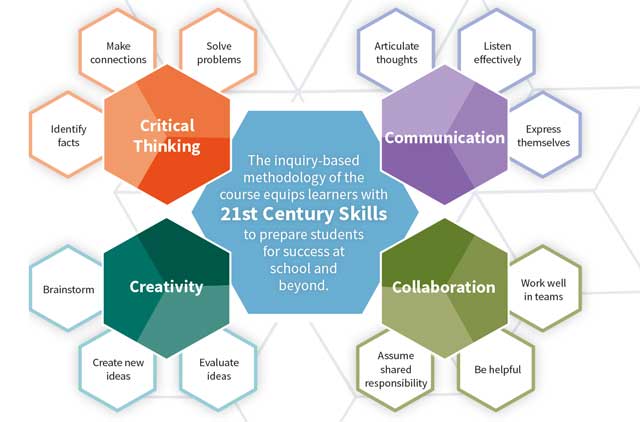
Please join our webinar for secondary teachers on Sunday 20 December to learn more and see some practical examples of activities for inquiry-based learning from Oxford Discover Futures.
Top Marks for Stretch

I teach in a private Japanese high school and recently started using the OUP title, Stretch with my 2nd grade students. It has made a huge and very positive impact on my teaching and on my students’ overall enthusiasm for English class. I think it worth sharing my experience as I’m sure that other teachers and students could benefit from this comprehensive and well-designed textbook. Here are some of the features of the course which have been particularly useful for my classes.
Visual support. The key vocabulary for each unit (usually eight words or phrases), is clearly illustrated and set out at the top of the Vocabulary and Listening page making it easy for students to gain immediate access to meaning.
Brief but focused listening exercises, which help students to identify and understand how the language is used in context.
Realistic dialogues for communication practice, providing opportunities for deeper understanding and internalization. The creators of Stretch have taken great care to include uncontrived, natural pieces of discourse spoken clearly by an interesting range of voices.
Communicative grammar practice. English grammar can be a confusing, dry and difficult aspect of language to teach. However, Stretch presents structures clearly and systematically, and allows students to practice with fun activities.
Interesting readings on a wide range of topics, which recycle previously taught language.
Video clips from actual news stories on the Viewing page. These lead into discussions and help introduce some of the benefits of student-centered teaching approaches such as Inquiry-Based Learning.
Presentation practice at the end of each unit, which scaffolds and encourages students to present well. Indeed, professionals as well as novices would be well advised to read through the Presenting tips as they provide a solid foundation for great presentations.

My students really enjoy Stretch and having spent more than half of my life in classroom settings trying hard to make the subject come to life I have found a new best friend in Stretch. I have taught from dozens of commercially available textbooks over the years but none have given me as much confidence, support or ideas and inspiration as Stretch. It is a massive achievement that so much has been put into one course book gifting teachers the means to create and curate lessons that positively impact a wide range of students.
Video for Communication
There are many benefits to using video clips to enhance an English course: they help keep students interested; put language in context; and add variety to classes. In addition, videos can be used to develop students’ communication ability. In this article, we will look at two types of video clip and how they can be used to get students talking.
Communication models
When students practice simple conversations in pairs, there is a danger that they will speak mechanically without thinking about the context or non-verbal aspects of communication such as gestures, facial expressions, and so on. Videos in which actors play out a scene can help bring the conversation to life for students, and provide models for both pronunciation and body language.
Here are some ideas to get students speaking before and after watching short conversations.
Before viewing
Put the dialogue in order
Divide the class into groups. Prepare a copy of the conversation for each group cut into strips. Each student takes a random line from the conversation. Students take turns reading their line to the rest of the group and then work together to put the lines of the dialogue in the correct order. Play the video and let students check their answers.
What will the characters say?
Using a picture of the dialogue, ask the students to predict something about one of the characters, which will be revealed in the conversation, for example., What is this character’s favorite music?. Students discuss in pairs and then watch the video to check their predictions.
After viewing
Act out the dialogue
Have students read the dialogue in pairs, making sure they copy expressions and gestures which they saw the actors use. Students change partners and practice several times.
Personalize the dialogue
Have students change a few key words in the dialogue to make the information true for themselves. Then, practice again with different partners.
Documentary videos
Short documentary-style clips on a variety of engaging topics such as interesting places wildlife, music, food, etc, can expand students’ knowledge of the world and lead to cross-curricular and cross-cultural study. These clips are usually narrated in graded language, so that students will be able to understand the contents well.
Here are some tips to get students talking before, while, and after watching short documentary clips.
Before viewing
Pre-viewing discussion
Have students discuss questions in pairs or groups. Questions can be designed to:
- Activate students’ knowledge of the topic
- Make predictions about what they will see
- Encourage students to think about what they want to learn from the video
While viewing
Silent viewing
Play the video clip without sound. Then ask students to describe what they saw to a partner and feedback to the rest of the class. If necessary, use a few questions to focus students’ attention on key areas. Next, play the video again with the sound turned up.
Audio only
Play the video clip with the screen turned off so that students can only hear the narration and background noises. Again, students could tell a partner what they heard or you could have them listen for specific information. Next, play the video again with the screen turned on.
After viewing
Post-viewing discussion
Have students discuss questions in pairs or small groups. Questions can be designed to:
- Personalize the concepts and get students describing their own experiences
- Compare an aspect of foreign culture with life in the students’ own country
- Have students give their opinion about an issue related to the video
Project work
Students can make posters, videos, etc on topics related to the video. It is important to allow time for students to brainstorm in their groups before starting to increase communication and allow them to practice their collaboration skills, working in a group towards a common goal.
Presentation practice
Students can give presentations to report back after their discussions, to present their posters, or as part of video assignments. This encourages students to put their ideas into a logical structure (typically thesis statement, reasons, examples, conclusion), builds confidence in speaking in front of other people, and develops their ability to speak at length about a topic.
Teaching Techniques from Let’s Go 5th Edition Teacher's Guide Vol. 3
This is the final in a three part series of articles that introduce how language is taught in our bestselling primary course book Let’s Go and some suitable teaching techniques to use along with the course.
Read the first article
Read the second article
Please also visit the Teacher’s Resource Center for more teaching techniques and resources.
*To access the Teacher’s Resource Center, use the access code on the inside cover of the Let’s Go 5th edition Teacher’s Pack.
Teaching with Can-Do Statements
Can-do statements allow both teachers and students to assess students’ progress on a continuing basis. At the end of each lesson, students demonstrate understanding through a fun, collaborative Can-Do Activity on the Student Book Classroom Presentation Tool. Depending on the size of the class, the activity can be done in groups or pairs. If students are able to complete the task, have them check the I can do this lesson box in the Student Book. If students are unable to complete the task, refer to the Games and Activities and Additional Resources sections for further support, Use the Workbook Classroom Presentation Tool for further teacher-led practice activities.
An oral Can-Do Activity accompanies Let’s Review in Let’s Begin 2 and Levels 1-2. First as a class and then in groups or pairs, students are encouraged to use the language they have learned in previous units. Have students take turns asking and answering the question. Monitor their progress. If students have successfully reviewed the units’ language, praise them for their accomplishments in English!

Teaching Phonics and Reading
Students learning English as a foreign language need to develop an oral language base before beginning to assign sounds to letters for reading instruction. Students learn to decode, or read words, by connecting sounds to the letters of the alphabet in various combinations. Let’s Go introduces key contrasting pairs of consonants, short vowels, long vowels, blends, digraphs, and diphthongs. Students hear the sounds in the context of the words, and then the pronunciation is reinforced by a fun Phonics Chant. Reading becomes the reward for learning new phonics patterns. The reading passages in Let’s Go use the lesson’s phonics focus words and familiar grammar in an enjoyable story that students can read along with the audio or independently. All new Workbook readings provide additional practice with the language, grammar, and unit themes.
Teaching Writing
The easiest way for students to gain confidence writing in a foreign language is to begin by following a clear model. Models allow students to express themselves creatively without being responsible for all of the grammar and spelling required in completely open writing exercises. Students can personalize the grammar patterns in Let’s Learn and Let’s Learn More by using the sentences as models to write about themselves. The Let’s Read stories in levels 1-6 can also be modified to become models for students to write their own similar stories.
The Let’s Read About sections in levels 3-6 always include writing personalization activities. A good writing expansion activity is to have students work together to create a unique story incorporating familiar grammar and vocabulary, based on a picture or a shared class experience. You can write the story sentences on the board, and the class can work together to correct the language. Students can read what they’ve written and copy the story into their own notebooks and illustrate it. Activities like this allow students to write and read at their own skill level.
Teaching Content (CLIL)
Let’s Go teaches high-frequency vocabulary and grammar in subject-related contexts that easily lend themselves to CLIL expansion for teachers who have more contact time with students. For example, a lesson talking about colors and shapes can easily become an art lesson about creating things using colors and shapes, or how mix colors. Let’s Read and Let’s Read About also include content connections as children use their developing skills in English to learn about the natural world, science, history, social studies, and geography. Teacher’s Guide lessons include expansion ideas to build on content connections.
You can find the full version of the Let’s Go 5th edition Teacher’s Guide (English only) and variety of useful teaching resources for the course at the Oxford Teachers’ Club.
And for learning at home, access our Learn at Home hub to discover online resources and activities to support teachers, parents, and students.
Coordinating classes at a Japanese university during the Covid-19 crisis: An interview with Leander Hughes
2020 saw a highly challenging start to the new academic year, with school closures and the state of emergency declaration forcing colleges and universities to move their classes online while maintaining their high levels of education. We spoke with Leander Hughes, Associate Professor at the Center for Education and Development at Saitama University, about his experiences coordinating and teaching classes during the first semester of this year, and how he feels the situation will develop as we continue to navigate the new normal.
How were English classes conducted at Saitama University during the first semester of this year?
Classes were conducted online, mostly real-time via Zoom.
What kind of digital resources did you use to deliver lessons? Which were most helpful to run classes smoothly?
We use Q: Skills for Success in our classes, which offers digital components including an e-book and an online practice site. The e-book versions of the textbooks were extremely helpful, as were the pdfs of the textbook answers and audio/video transcripts (important sections of which could be shown to learners via screen sharing). Q Online Practice activities and tests were also indispensable.
How did teachers transition from teaching classes face-to-face to online? What were the common questions/issues that arose?
The transition was smoother than we expected, but questions/issues included:
- How to ensure that students enrolled in the class would obtain the Zoom meeting info necessary to join class (and that others would not have access to that information)
- How to take attendance
- How to ensure and monitor class participation in large classes
- How to securely administer tests online.
- How to obtain homework assignments (aside from Q Online Practice work) in an efficient manner
- What to do about students who could not (or would not) join real-time classes, but who still wanted to earn credit
What was the biggest challenge for your students?
Probably adjusting to communicating in pairs and larger groups through the Zoom medium rather than in person.
Have your students experienced any benefits from learning remotely?
I've noticed that particularly in my smaller classes, the general quality of my students' work has improved. I think that this is mostly because of their having more time to work on their assignments due to the general stay-at-home policy. Attendance is also higher I think mostly because getting to class is a lot easier now. Another benefit is that, in some ways, it is easier for students and teachers to share materials with each other through using their computers and the screen sharing function. If I am teaching a large class in a traditional face-to-face environment, I have to bring my computer and hook it up to the projector in order to share something (or print out copies for everyone). Likewise, students must also either bring their computers or print whatever information they are to share. With remote learning, we are already on our computers and can immediately share whatever is on our screen with the click of a button. I teach an ESP class on web programming, and have found it is actually EASIER to teach this class through Zoom than in a traditional classroom mainly because of the ease of sharing our screens.
How do you see classes continuing for the rest of this year? Will there be a blend of face-to-face and online classes?
It seems like coronavirus will not be going away any time soon, so we are prepared to teach online the rest of the year if that is what is needed to protect our students, faculty, and staff. I will be very happy though when the day comes that we can safely return to the physical classroom.
What advice would you give to teachers who need to transition to online lessons?
- Set up and frequently update a Q&A page devoted to helping your teachers transition. The page should list all of the steps teachers need to take to get their courses up and running and offer trouble-shooting for whatever issues arise.
- Have an open channel of communication for all of your teachers to make their questions/issues known and also provide each other feedback and update your Q&A page based on those issues and the solutions provided.
- Create short to-the-point video tutorials specifically tailored to helping your teachers with any technically tricky aspects of their course set-up. I created a tutorial, for example, on how to get students registered for Q Online Practice and access the digital versions of their textbooks. To ensure maximum effectiveness, the faculty in charge need to first set up their own courses exactly how they expect other teachers to do it, note problems that arise and create tutorials that specifically address those issues, providing the bare minimum information required for teachers to successfully set up their course. Once teachers have set up their course and have gotten somewhat comfortable with it, they will be in a better position to learn more about all of the capabilities and options provided to them by the technologies they are using.
- Be flexible. Get ready for students telling you they couldn't attend class because of a bad internet connection or because of problems with their computer and prepare alternative assignments for such students to do in order to receive credit for the missed class(es). Make sure you have a reliable way to contact all of your students and provide guidance in the case that you yourself experience unexpected computer trouble in the middle of a class.
- Communicate with your students about class. When you have a chance, ask a student one-on-one about how the online class is going for them. A good strategy to create opportunities to get one-on-one feedback about class is to make time at the end of class for students to ask questions and to allow students who do not have any questions to leave. Sometimes after helping a student who stays with a question, I ask them about the class in general and listen to their feedback. Through such one-on-one talks, as well as through emails with students and a class-wide votes using the chat function, I learned some interesting things. For example my students preferred groups of three rather than pairs for breakout-room communication activities because it relieved pressure, but for checking homework students preferred groups of four, because it increased the chances that someone would be able to answer a question posed by a group member. Interestingly, students have said that once they are back in the physical classroom, they prefer working in pairs again for these activities!
Teaching Techniques from Let’s Go 5th Edition Teacher's Guide Vol. 2
In this series of 3 articles, we will introduce how language is taught in our bestselling primary course book Let’s Go and some suitable teaching techniques to use along with the course. Please also visit the Teacher’s Resource Center for more teaching techniques and resources.
*To access the Teacher’s Resource Center, use the access code on the inside cover of the Let’s Go 5th edition Teacher’s Pack.
Teaching Contractions
Learning how to use contractions like isn’t and I’m helps students to sound more fluent and to better understand natural English, and gives them an advantage when they begin to read and write. Contractions are explicitly taught the first time they appear in Let’s Go and should be reviewed, as needed, in the later lessons. Use the Contraction Cards on the Teacher’s Resource Center to show students that contracted and non-contracted language are equivalent.
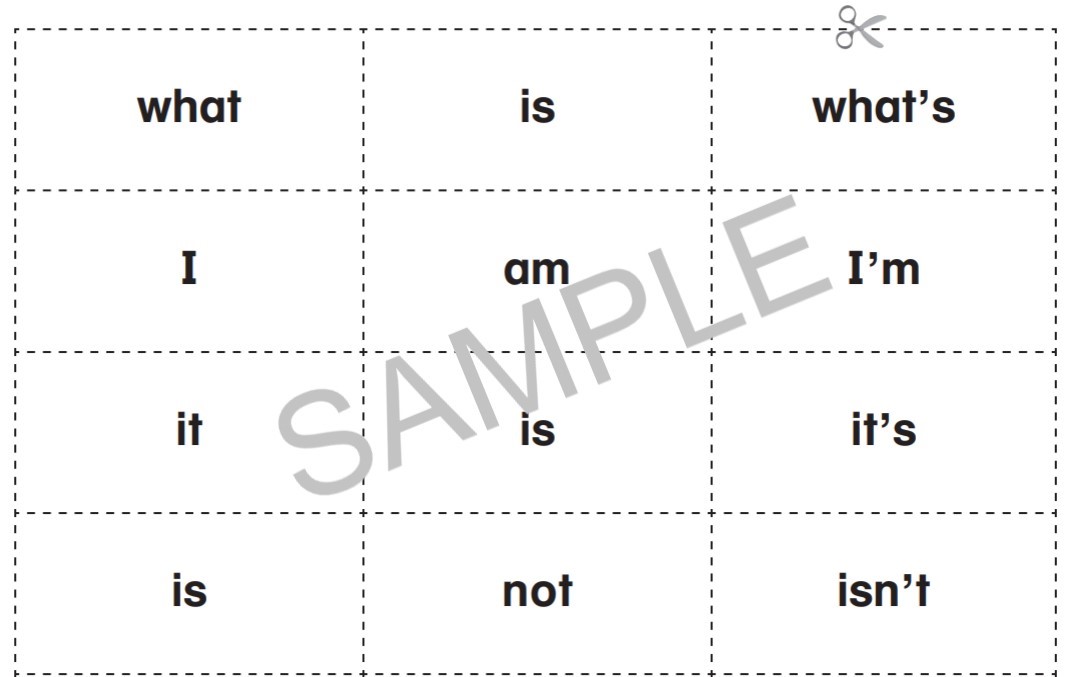
How to Practice Language in Groups and Pairs
Start with full class practice so that students don’t feel shy or embarrassed. Be sure that students practice the language using natural speed, rhythm, and intonation. Then divide the class into two groups. One group asks the questions and the other answers. Even in practice like this, try to give students a reason for asking and answering the questions. For example, if you’re practicing the question “What do you like?” only show the Teacher Cards of animals to the answering group. This way, the questioning group has a real reason to ask because they don’t know what the answer will be.
Then group students in pairs or small groups for additional practice with the question-and-answer pattern. By moving from the large group to the small, students build confidence by practicing before their voices become individually heard. As students work together, move around the room so that you can hear what problems students are having, and can address the problems with a mini-lesson later on for the entire class (rather than correcting just one student). Variety in grouping and activities also gives students a lot of practice opportunities that don’t feel like practice. If the pace is quick and activities change frequently, students will pay close attention.
How to Use Songs and Chants
Animated videos show language in context and provide models for pronunciation and body language. The animated videos in Let’s Talk bring the Let’s Go Characters to life and extend the conversation students learn in Listen and say. The extended conversation incudes new and familiar language, and is highlighted in blue in the video script. The animated song and chant videos in the Let’s Begin series and levels 1-3 use key vocabulary to engage students and motivate learning.
Author, singer, and composer Carolyn Graham urges teachers to write their own phonics chants. Chanting helps children memorize the sound(s) the letters stand for. Create silly or serious phrases with words that students enjoy saying, and put them into sentences that make up a four line chant. Say each phrase of the chant before you put it all together. Then say the chant together.
Teaching with Video
All language builds from a base sentence. For example, from the sentence “He likes cats.” students can build the question “What does he like?” In the early levels of Let’s Go, these patterns (sentence, Wh- question, Yes/No question) are explicitly taught. However, later lessons and levels might only teach the sentence and Wh- question, or both questions but not the sentence. Teachers should remind students that they know how to build language even if it is not explicitly taught in every lesson. In the same way, once students have learned how verbs change with different pronouns, or how nouns change to become plural, they should be encouraged to practice the different forms, even if not specifically taught in a lesson.
When teaching with video, first play the video and have students watch. Encourage students to identify familiar language and respond to any speaking prompts. Next, assign students a simple task to complete as they watch the video a second time. For example, students raise their hands when they hear key vocabulary. Pause the video after each exchange to give students an opportunity to repeat the language and act out the gestures. Then act out scenes from the video with one or more student volunteers. Finally, have students practice the extended conversation in small groups or pairs, using gestures and actions from the video as appropriate.
You can find the full version of the Let’s Go 5th edition Teacher’s Guide (English only) and variety of useful teaching resources for the course at the Oxford Teachers’ Club.
And for learning at home, access our Learn at Home hub to discover online resources and activities to support teachers, parents, and students.
Teaching Techniques from Let’s Go 5th Edition Teacher’s Guide Vol. 1
In this series of 3 articles, we will introduce how language is taught in our bestselling primary course book Let’s Go and some suitable teaching techniques to use along with the course. Please also visit the Teacher’s Resource Center for more teaching techniques and resources.
*To access the Teacher’s Resource Center, use the access code on the inside cover of the Let’s Go 5th edition Teacher’s Pack.
Teaching Conversation
In teaching conversation, the goal is for students first to become fluent using language, and then to focus on becoming accurate with it. Let’s Talk introduces useful phrases (greetings, introductions, asking for and giving help, etc.) in functional conversations. First, students listen to the entire conversation, which introduces the language in context. Then they focus on the functional language in the language focus box. Students learn the intonation and rhythm of the language, first in an animated video of the extended conversation and then in a song or chant. This is the easiest way for children to remember the language well. Finally, students personalize the language in Say and act.
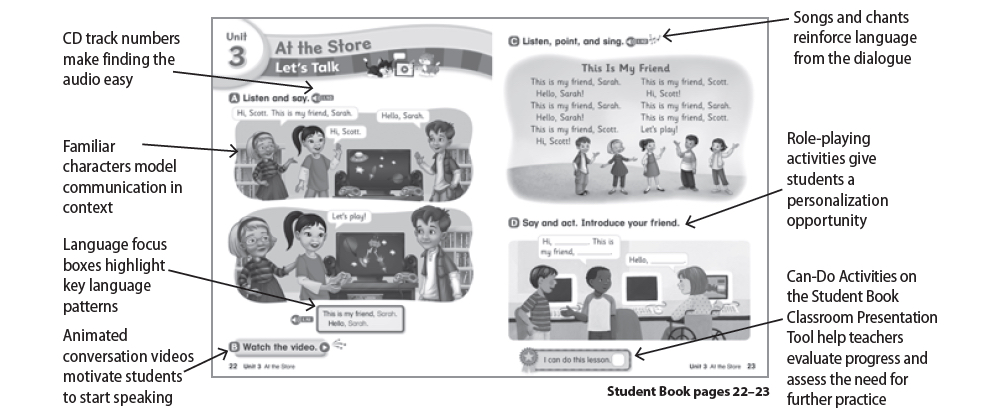
Teaching Vocabulary
Use objects or Teacher Cards to present new key words. Hold up an object or card and say the word. Have students repeat the word several times. Then practice the word with drills, using familiar language whenever possible.
The Let’s Go Teacher’s Guide describes a number of drills and activities designed to develop and reinforce the students’ vocabulary knowledge. There are two types of vocabulary or language that all language learners develop ― receptive language and productive language.
Receptive language is the language students understand but are not yet able to produce. To practice receptive language, students must recognize and physically respond to vocabulary words. For example, place several Teacher Cards at the front of the class and select two student volunteers. Say one of the vocabulary words and have the students race to touch the correct card. Whoever touches the card first is the winner.
Productive language is the language spoken by students. Productive language practice requires students to say the vocabulary words as they identify the objects. Play the game as described above, but have the students touch the correct cards and orally identify the objects.
Teaching Grammar
In Let’s Go, grammar is taught in context so that students understand the meaning and conversational purpose. Students first learn new vocabulary words that relate to the unit theme. Next, students see and practice the language in a mini-conversation context. Then they practice the question-and-answer structures in a video, game, activity, song, or chant. Students should understand that vocabulary and grammar patterns are productive, build on each other, and can be used with other patterns, so language is recycled in the units.
In teaching grammar, the goal is for students first to learn language accurately, and then to focus on becoming fluent in using it. For the most efficient use of class time, teach vocabulary first. Then introduce a new sentence pattern and recycle the vocabulary words as students practice the sentence.
Then when you introduce a Wh- question, students already know the answer to the question. In this way, students can accurately build a great deal of language in small steps, and they won’t confuse the question with the answer.
Be sure that students understand the meaning of the new language and can pronounce the words clearly before moving on to practice. Correct pronunciation is introduced during the modeling by the teacher so that students can strive for accurate pronunciation as they are learning the meaning of new vocabulary.
When teaching Yes/No question-and-answer patterns, have children answer with answers that include the auxiliary verb from the question (Do you like cats? Yes, I do. No, I don’t.). Not only does this help students remember the questions and answers grouped in a memory set, it also builds a grammar foundation that will help them learn to write English more easily.
Separate the Yes and No answers in practice at first so that students don’t confuse the meaning. Then mix Yes and No answers.
Recycling Language
All language builds from a base sentence. For example, from the sentence “He likes cats.” students can build the question “What does he like?” In the early levels of Let’s Go, these patterns (sentence, Wh- question, Yes/No question) are explicitly taught. However, later lessons and levels might only teach the sentence and Wh- question, or both questions but not the sentence. Teachers should remind students that they know how to build language even if it is not explicitly taught in every lesson. In the same way, once students have learned how verbs change with different pronouns, or how nouns change to become plural, they should be encouraged to practice the different forms, even if not specifically taught in a lesson.
You can find the full version of the Let’s Go 5th edition Teacher’s Guide (English only) and variety of useful teaching resources for the course at the Oxford Teachers’ Club.
And for learning at home, access our Learn at Home hub to discover online resources and activities to support teachers, parents, and students.
How Do Online Lessons Work in Practice?
Many schools which have had to suspend classes in response to the spread of coronavirus are now considering online lessons as an alternative. This may seem challenging for those without experience of e-learning. However, with the right devices and tools for online communication, it’s relatively easy to hold online classes of the same quality as your normal lessons. There are currently many universities and language schools holding their classes online, and many junior and senior high schools are now considering this as well.
We recently had a conversation with Mr. Satoru Suzuki from Ryogoku Junior/ Senior High School about holding online classes and he shared his thoughts.
(Classes at Ryogoku Junior/ Senior High School are not currently being held online, but Mr. Suzuki has undergone trial lessons as an experiment with some students and other teachers using the online communication tool, Zoom.
The advantages of online classes - from the teacher’s point of view
- Teachers can see each student and their facial expressions better than they could in the physical classroom
- Students cannot chat with their friends without others hearing, so they concentrate on the lesson better
- Using available functions for group discussions and pair work, it’s possible to simulate the same activities as in a normal class
- It’s easy to upload and share files
The advantages of online classes – from the students’ point of view
- Students need to speak clearly to be understood, so it’s good speaking practice
- Students can raise their hand using a ’raise your hand’ function just like they would in a normal class
- Students can ask questions and give their opinions with the chat functions
- Students can focus on the lesson as they are not distracted by chatting with friends
- During group discussions students are required to tackle problems together in their groups, which allows them to learn important skills such as leading discussions and summarizing main points
Points to consider when teaching online for the first time
- Teachers should practice together before the class, so that they can familiarize themselves with the functions of the platform they are using
- If teachers can experience using the software and viewing the class as a student, it can help the class to go more smoothly
- Confirm all students have WIFI and a device (PC or mobile device) which they can join the lesson on
- Teachers and students should have a test session at least once before the class to check the, connection, audio and other functions
- If possible, try to hold the first few classes with fewer students (under 20)
Students may feel it’s a little strange to speak with the teacher and each other through a screen and can be nervous at first, but they soon get used to it and focus on the lesson. Online lessons from home while schools are closed is a great way to help transition smoothly back to regular classes when students return to school, and providing regular chances for teachers and students to communicate online will help everyone through this difficult time.
Here are some more articles related to online learning (English only):
An Interview with Kathleen Kampa on using Online Tools to Support Student Learning while Schools are Closed due to the Coronavirus Pandemic
1. What is the current situation at your school?
We started “Home Learning” at my school (an International School in Tokyo) on March 4th. We will continue online through the end of our school year, which is early June.
My home English classes continued at home with masks on and thorough hand washing until just a few weeks ago. My class with little ones met outside in the park—masks on.
2. With classes limited or closed, how are you supporting student learning?
Each area of my school offers our program based on the age of the students and their unique needs.
Our kindergarten teachers have been preparing packets of activities which were sent to families. They are using blogs which they had done before, and implemented Seesaw for the first time. They regularly reach out to families via Skype or Google Meet to check in. Teachers had three days to prepare videos before we went “live” with our learning. We created YouTube videos for a bank of stories and songs.
Our Elementary School is using a variety is technology to meet the needs of the students, including Seesaw, Google Classroom, Loom, Screencastify, and more. Homeroom teachers keep a record of the activities for the day. Single subject teachers copy their plan into a shared Google doc. Many teachers have simplified versions for students to check on a daily basis. Teachers are using Zoom to connect with small groups of students.
Our Middle School and High School are continuing their regular class times, usually on Zoom.
For my home English classes, I’ve tried a couple of things so far. When the situation wasn’t too bad, I had a Magic Time class at the park. Everyone wore a mask. We could do a lot of new activities connected to the book. Now that the situation has gotten a little worse, I’ve been sharing short YouTube videos with my students, some that I’ve made and others I’ve found that are helpful.
For my Everybody Up class (LEVEL 6), we have gone to Zoom for our classes. So far, it’s been going well. I set up the materials I need for class. I’ve been trying to find online ice breakers and games to keep students fully engaged. I also bring something humorous like an Easter bunny!
3. What are some of the challenges you faced when starting to use technology to support students or deliver lessons?
Some of the challenges have to do with what each delivery system offers. Some of my Japanese parents didn’t understand what they needed to do to get started. How do I sign up for Zoom? What do I need to have ready? How do the students interact in this online environment? How do they raise their hands? How do we sing together? How do we check homework and look at a page from the book?
YouTube videos have been successful for many. With a better camera, lighting, and sound, the end results are quite good. Teachers still need to plan a cohesive lesson.
4. What are some benefits of teaching online lessons?
I’ve noticed things in my online lessons that I hadn’t noticed before. Depending on the way a lesson is delivered, I can see new benefits. Seesaw has been a spectacular tool for delivering a short lesson and seeing students’ response. You can give students individual feedback in a written or aural form. My students have found things at home and integrated their knowledge. I’ve also found that whatever I “model” in my lessons in a video, many students will copy what I’ve done. i.e. If I use props, costumes, specific phrases, I will see my students doing what I did. So, my advice is to know what you want to see at the end of the lesson.
5. What is the biggest learning point you can take away from the whole experience?
I have a few points. First of all, we’re all human. Our lessons may not be perfect, but we can try our best with the energy and resources we have at this time. Secondly, we can create beautiful lessons if we make them a little more open-ended. Can we give our students tasks that allow them to connect with what they have at home? Lastly, we need to give our students time to connect with each other, too.
Remember...some days will be tough. Others will be amazing. The technology may just fail, and then you’ll find a way to teach your students in a new way. Be flexible. Be creative. Be organized. Look for the magic in the moment.
Kathleen Kampa is an American ELT author and teacher-trainers who has taught young learners in Japan for over 25 years. She is co-author of Magic Time, Everybody Up, and Oxford Discover, all published by Oxford University Press. She is an active teacher who promotes an inquiry-based approach to learning, where students develop English language fluency as they discover the world around them.
Event Report -– Oxford Reading Tree Tadoku Workshop
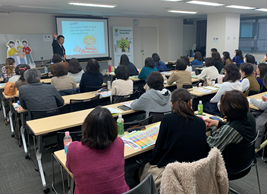 On February 22nd, 2020 we held the Oxford Reading Tree Tadoku Workshop in Nagoya with the aim of sharing ideas for using Oxford Reading Tree in Secondary Schools. We had three amazing presentations from Oxford reading Tree experts, Tetsuro Nishiyama (Kori Nevers Gakuin Elementary School), Hiroko Moroki (A & A ENGLISH HOUSE) and Jugo Tanaka (Seinan Gakuin Junior & Senior High School) and were joined by nearly 40 enthusiastic teachers who brought their own experience and ideas to the workshop.
On February 22nd, 2020 we held the Oxford Reading Tree Tadoku Workshop in Nagoya with the aim of sharing ideas for using Oxford Reading Tree in Secondary Schools. We had three amazing presentations from Oxford reading Tree experts, Tetsuro Nishiyama (Kori Nevers Gakuin Elementary School), Hiroko Moroki (A & A ENGLISH HOUSE) and Jugo Tanaka (Seinan Gakuin Junior & Senior High School) and were joined by nearly 40 enthusiastic teachers who brought their own experience and ideas to the workshop.
4 Tips for Teaching Global Skills in Primary EFL Classes
In a fast-changing world, it is widely accepted that global skills are vital for today’s learners to be able to fully participate in 21st century life. But which global skills can be taught in ELT settings?
In our latest position paper, Global Skills: Creating empowered 21st century learners, the Expert Panel identified the skills that are especially relevant to the English language classroom and organized them into five clusters:
- Communication and collaboration
- Creativity and critical thinking
- Intercultural competence and citizenship
- Emotional self-regulation and wellbeing
- Digital literacies
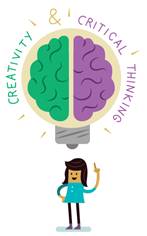
So how can these skills be taught to EFL students in primary and even pre-primary classes in Japan? Below are four ideas that you can try.
1. Get students to put vocabulary into categories
 Students need to do more than acquire information; they need to make sense of the information by thinking about it critically. For young learners in an EFL environment, simple categories are fine. For example, which are the primary and secondary colors? Which animals can fly? Which animals can swim? What clothes do we wear in different seasons? Categorizing information is an important skill for critical thinking, and students can begin practicing this skill at an early age with tasks appropriate to their level. Courses such as Everybody Up contain plenty of achievable activities to get students thinking critically.
Students need to do more than acquire information; they need to make sense of the information by thinking about it critically. For young learners in an EFL environment, simple categories are fine. For example, which are the primary and secondary colors? Which animals can fly? Which animals can swim? What clothes do we wear in different seasons? Categorizing information is an important skill for critical thinking, and students can begin practicing this skill at an early age with tasks appropriate to their level. Courses such as Everybody Up contain plenty of achievable activities to get students thinking critically.
2. Put students into small groups to complete project assignments
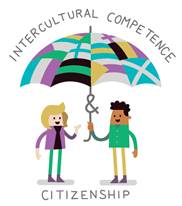 Having students work towards a common goal builds their communication and collaboration skills as they negotiate meaning and make decisions together. In addition, project work strengthens critical thinking and encourages creativity in the classroom. Even young learners with limited reading and writing ability in English can work on fun and engaging projects such as making a robot or designing a restaurant menu. When students have finished, they can give a short presentation using simple phrases for further communication practice. Finally, displaying students’ work in the classroom builds motivation and creates a positive learning environment. Courses such as Everybody Up and Oxford Discover have many great project activities.
Having students work towards a common goal builds their communication and collaboration skills as they negotiate meaning and make decisions together. In addition, project work strengthens critical thinking and encourages creativity in the classroom. Even young learners with limited reading and writing ability in English can work on fun and engaging projects such as making a robot or designing a restaurant menu. When students have finished, they can give a short presentation using simple phrases for further communication practice. Finally, displaying students’ work in the classroom builds motivation and creates a positive learning environment. Courses such as Everybody Up and Oxford Discover have many great project activities.
3. Use a story-based approach
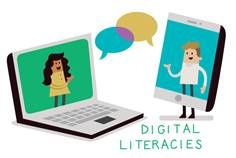 Stories engage students and put language into a realistic context. In addition, by understanding the feelings of different characters in a story, children develop their emotional self-regulation. It is important to ask questions about the themes for personalization and to encourage students to predict what will happen next. When the teacher does this, students become actively engaged, thinking critically about the story and communicating their ideas. Depending on the theme, there are often chances to learn about foreign cultures through the story, helping students with their intercultural competence. The brand new course Learn English with Dora the Explorer offers a video story in every unit. There are also hundreds of stories available to read online from the Oxford Reading Club, which can be used on a variety of devices and develop students’ digital literacies.
Stories engage students and put language into a realistic context. In addition, by understanding the feelings of different characters in a story, children develop their emotional self-regulation. It is important to ask questions about the themes for personalization and to encourage students to predict what will happen next. When the teacher does this, students become actively engaged, thinking critically about the story and communicating their ideas. Depending on the theme, there are often chances to learn about foreign cultures through the story, helping students with their intercultural competence. The brand new course Learn English with Dora the Explorer offers a video story in every unit. There are also hundreds of stories available to read online from the Oxford Reading Club, which can be used on a variety of devices and develop students’ digital literacies.
4. Teach values
It is important for children to learn about positive social behavior such as helping your friends, saying nice words, sharing your toys, being fair, being kind, etc. This will help them to collaborate with other students and develop a socially healthy lifestyle (an important part of emotional self-regulation). Courses such as Everybody Up and Learn English with Dora the Explorer include values as part of the syllabus.
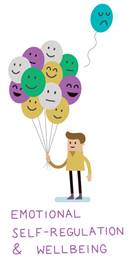
Teaching the Whole Child
Young children are always learning. Every day, they absorb more information than adults would ever imagine. In particular, children aged 3-6 develop rapidly in a variety of ways. What do teachers of kindergarten-aged students need to be aware of? And what skills do students need to learn for the future?
In Japan, the term zenjin kyoiku is often used to refer to comprehensive education which develops not just children’s knowledge and academic skills but also areas such as sensitivity and values. There is a similar philosophy in western countries called the “whole-child” approach. In addition to academic abilities, teachers using this approach will also pay attention to a wide range of areas including physical development and gross motor skills (such as walking and sitting), the knowledge and skills necessary for social interaction (such as overcoming anxiety and difficulties) and social-emotional ability. The objective of teaching the whole child is to help them achieve their dreams. As teachers we should keep in mind that English teaching is connected to the enhancement of a variety of skills, and create a classroom environment and lessons which focus not just on improving language skills but also on drawing out all of the children’s abilities. A positive learning environment is one in which students feel safe and secure and provides an organized system of support. Lessons which stimulate students’ curiosity and sometimes challenge them with difficult problems provide the key to success.
It’s important that we create a classroom environment in which the child feels, “This is a safe place.” If we can achieve this, the child will feel that classes are fun, and want to continue studying and learn more. For example, using puppets to communicate with students will help build a relationship of trust. Also, it’s important to watch each child closely and be flexible in our teaching approach, adjusting our methods according to the children’s ability and improving lesson planning each time.
Next, let’s talk about creating lessons which keep all children engaged. Children have different learning styles. These are often divided into three categories - visual, auditory and kinesthetic (VAK). For example, visual learners learn well from videos, picture books and kamishibai; auditory learners respond well to songs, chants and listening activities; and kinesthetic learners like using gestures and activities in which they use their whole bodies.
Learn English with Dora the Explorer is a brand new course for pre-primary English learners. It deftly balances activities for the VAK learning styles with a reliable syllabus which allows teachers to adopt a whole-child approach to teaching. In the coursebook, students learn alongside the much-loved character Dora the Explorer and grow their social-emotional ability while learning useful English phrases. Social-emotional ability is a non-cognitive ability which can’t be measured in an IQ test and includes social skills, cooperation and self-control. Developing students’ social-emotional ability involves getting them to understand rules, the importance of human relationships and how to get along well with other people. In this course, the animations and story cards with Dora strengthen students’ non-cognitive ability and stimulate their knowledge and curiosity. The course is filled with activities which employ the VAK model such as Action Songs in each unit, videos which introduce new vocabulary, activities using gestures, craft activities and many more. There are also a few more difficult activities to challenge the students. In this way, Learn English with Dora the Explorer delivers a whole-child approach and provides a fun learning experience. If you would like to teach students social skills and values as well as English, giving them skills which lead to a successful future, this is the course for you!
Getting going with Let’s Go
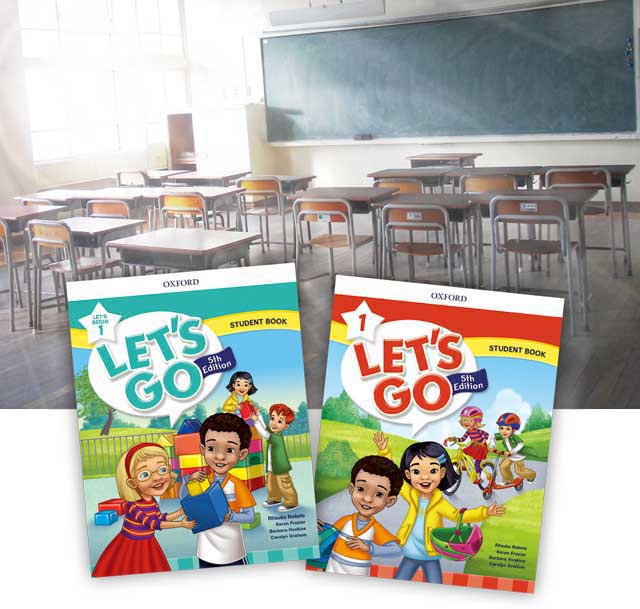
Choosing and adapting textbooks for your unique contexts can be one of the main influences on your students’ learning. When choosing a new textbook to use in your classroom, thinking about your students’ learning goals only is not enough. You have to also think about the affordances and constraints of your unique context. Who are your students? How many in a class? How often? Who will be teaching it? How does this textbook provide evidence of learning to parents? How can I use it for assessment? How much time do we have to adapt and expand upon resources? And, given the recent initiative of publishers towards digital and online support for paper-based resources, what hardware do I and my students have access to in order to maximize the benefits of those resources?
This year, our school has started to use Let’s Go 5th edition levels one to five for grades one to five. In this article we will tell you about our school and why we chose Let’s Go 5th edition to maximize our affordances and mitigate our constraints; and some things we have learned through using the textbook which we hope will prove to be useful advice for those considering whether to use Let’s Go or for those already using it.
Our school, Koriyama Xaverio Gakuen Elementary School in Koriyama city, Fukushima prefecture is a medium-sized Catholic private school with a roll of about 250 students. Our English program is an integral part of our curriculum and a critical point of difference between ourselves and the local public schools. Our first and second graders have two hours a week of instruction, our third, fourth and fifth have three hours a week, and our sixth graders have four hours a week.
Each classroom is equipped with a computer and whiteboard projector. We have also just purchased about 50 tablets for student use. Let’s Go 5th edition provides a classroom presentation tool, which allows us to display the student book pages on the whiteboard and play the audio and video, and an Online Play site for students which they can use on their tablets.
Most classes are team-taught. Our staff consist of one full-time, licensed English teacher, one full-time and two part-time ALTs, one homeroom teacher, and four junior high school teachers. Therefore, having a textbook which can be taught by a variety of teachers is essential.
Given we have two to three classes a week, we wanted a textbook that had a lot of vocabulary, especially in comparison to public schools. The new curriculum for elementary schools to begin next year has a corpus of about 700 words, which consists of both receptive (non-assessed) and explicitly-taught (and assessed) vocabulary. In comparison, over the five levels which we are using, the Let’s Go series provides 983 explicitly-taught words. The clear layout of the new vocabulary in each unit has meant that we are easily able to assign homework tasks which can be supported by the online picture dictionary (found on the online play site). However, many of our younger students are not able to do this by themselves, so we are now putting together an introduction to this resource in Japanese for parents to assist them.
The reaction of our students has been generally good. The students enjoy the videos that accompany the dialogues and chants, the clear focus of each lesson and the speaking tasks that accompany them. We initially thought the reading texts in each unit would be too difficult for most of our students, especially our third graders, given that the students had yet to learn many of the phonics rules to decode them. However, most were able to read with some fluency after being taught some reading strategies such as breaking-up the words, using the pictures for clues, trying to think what word would make sense in the sentence, and asking for help if all else fails.
Also, we appreciate the ability to modify the tests for each unit. Recently, we have adapted the syllabus by ignoring the second question and answer form in each unit, which tends to be a closed question such as, “Does he/she have a ____? Yes, she does/No, he doesn’t.” We have replaced this with additional statement drilling, such as “She/he has a _____.” in order to reduce the cognitive load of dealing with additional grammar forms and to thereby focus on learning the key vocabulary. The ability to modify the tests to accommodate this change is really useful.
In summary, the Let’s Go series provides a vocabulary-rich syllabus which is well supported by digital media. It suits us as we have two to three hours of classes a week so we can get through a level in a year. With this package, we are very happy to have gotten a lot of additional digital resources, some of which can be modified, to support and extend the base program. Like most textbooks, we needed to adapt it for our students. In this case, by reducing the amount of question and answer forms taught in each unit. However, we may be able to revisit these forms later in the year. We are just beginning on our journey of using and adapting Let’s Go for our unique context and the affordances it provides us. One of these is the increase in vocabulary and forms taught. This means we are challenged to provide creative ways to continuously revisit and use the language meaningfully and imaginatively, so that it is not forgotten but put to good use.
How to encourage children to be “smart” in 8 different ways
Rethinking intelligence
Children bring a range of intellectual abilities to the classroom. How can we celebrate and accommodate these different intellectual capacities in our lessons? One approach I’d like to elaborate on in this article is the Theory of Multiple Intelligences (MI). Developed by Howard Gardner, it argues that people are intelligent in many ways, more ways than IQ tests can measure. Other educators, including Thomas Armstrong, applied the theory to the classroom and made it accessible to all teachers and children.
| Gardner’s terms | How it works | Easy terms | Icons |
|---|---|---|---|
| Linguistic intelligence | can and like to use words | Word smart | |
| Logical-mathematical intelligence | can work with numbers and patterns | Logic smart | |
| Spatial intelligence | can work with spaces and images | Art smart | |
| Bodily-kinesthetic intelligence | can use the whole body and hands | Body smart | |
| Musical intelligence | can sing, has sense of rhythm and enjoys music | Music smart | |
| Interpersonal intelligence | can understand and work with others | People smart | |
| Intrapersonal intelligence | can understand oneself | Self smart | |
| Naturalist intelligence | can understand nature and classify | Nature smart |
How MI makes English teaching more effective
I’ve come to understand and appreciate MI theory through twenty years of experience as a visiting English language teacher in public elementary schools. In the beginning, I didn’t know how to manage a large class of 30 to 40 children. My lesson plans didn’t work well, some children remained silent and wouldn’t budge. Just as I was about ready to throw in the towel, I was asked to teach special educational needs (SEN) classes. Knowing each child had a specific need, I was careful to include different types of activities in one lesson. It worked! So I took what worked in SEN classes to mainstream English language classes. I kept visiting elementary schools to team-teach with homeroom teachers as I sincerely wanted to contribute to English education.
MI theory has helped me make well-rounded plans that don’t leave out any child. The MI pie chart below shows various types of activities for the eight different “Smarts”.
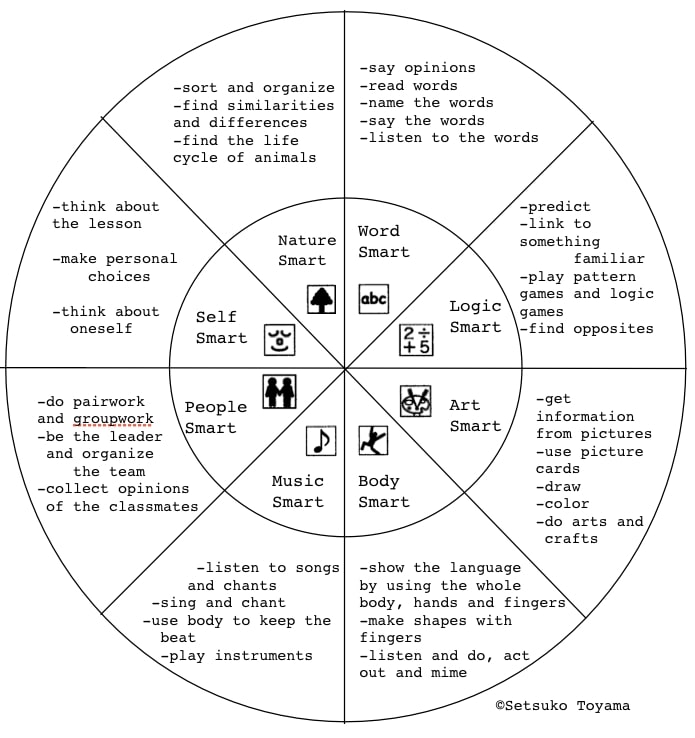
Demo lesson: using MI to teach the alphabet
Now, let’s say I’m asked to teach a third-grade class twice a month and the unit of the month is about the alphabet. First, I brainstorm all activities that are related to learning the alphabet. Then I use a blank MI pie chart as a mind map and put each activity into the appropriate column, like this:
Eight different “smarts” - specialized activities for learning the alphabet
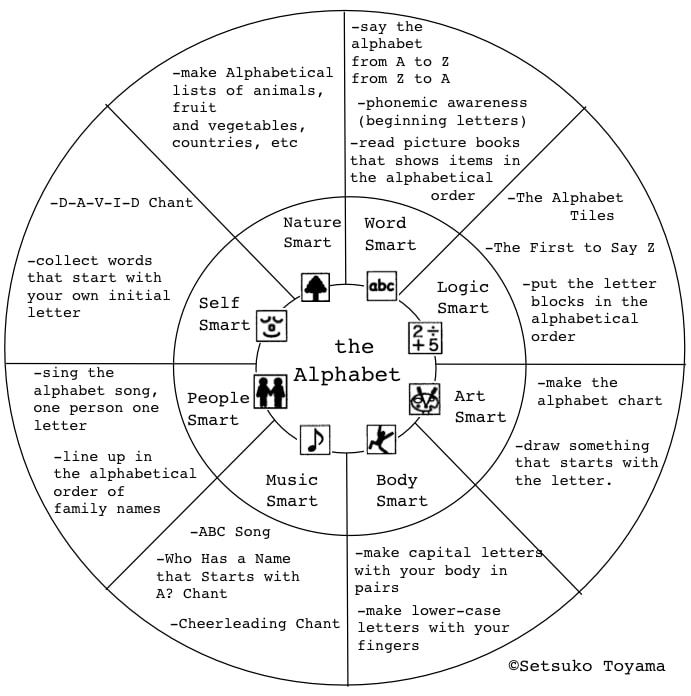
To estimate how long it’ll take to conduct each activity, I contact the homeroom teacher and ask whether the children are vocal and forward or quiet and cautious. This is because the personality of the class will affect the activity duration. Then I combine activities to make the first 45-minute lesson, in which I try to tap on children’s Music Smart, Body Smart, People Smart, and leave breathing space for everyone to get to know one another. Based on the observation of the first lesson, I will make the plan for the second lesson.
| Lesson | Activities | Preparation | MI |
|---|---|---|---|
| 1. | Greetings: get to know one another | ||
| 2. | ABC Song: point to the letters on the enlarged copy of the alphabet chart | -Alphabet chart -CD |
|
| 3. | Make capital letters with your body in pairs | -Alphabet chart | |
| 4. | Read “Eating the Alphabet” by Lois Ehlert | -Picture book | |
| 5. | Reflections: children think which activity was the most fun. Volunteers tell the class. |
The English lessons we conduct should give every child an opportunity to learn successfully and have fun. If you create lessons that enable children to make use of their individual strengths and to be smart in many ways, you’ll be a super teacher!
Setsuko Toyama is the co-author of the bestselling English Time series. She is a visiting professor at Keiwa College and works closely with elementary school teachers of English in Niigata.
Resources
Intelligence Reframed, Howard Gardner, 1999, Basic Books.
You’re Smarter Than You Think, Thomas Armstrong, 2014, Free Spirit Publishing.
In Their Own Way, Thomas Armstrong, 2000, Jeremy P Tarcher/Penguin.
脳科学を活かした授業を作る 本田恵子 2006 C.S.L.学習評価研究所
自分の強みを見つけよう〜「8つの知能」で未来を切り開く 2018 有賀三夏 ヤマハミュージックメディア
特別新学級外国語活動のためのストーリーを歌で楽しむ英語絵本セット指導マニュアル 外山節子監修・著 砂田由美子/本間アユ子共著 2011 コスモピア
特別新学級外国語活動のための歌とリズムを楽しむ英語絵本セット指導マニュアル 外山節子監修・著 砂田由美子/本間アユ子共著 2011 コスモピア
Eating the Alphabet, Fruits and Vegetables from A to Z, Lois Ehlert, 1996, HMH Books for Young Readers.
Watch highlights from Oxford Day 2018
At this year's Oxford Day, educators from all over Japan explored the global and local trends shaping language education. With plenary talks from Michael Swan and Catherine Walter, it was an exhilarating day of expert insight and knowledge sharing, ending with an enjoyable networking reception.
We offer an exceptional programme of events to help teaching professionals gain expert insight and connect with peers. Check our Events and Seminars page to see what's happening in your area.
*Recommended browser for viewing this video: Google Chrome, FireFox, Safari
Event Report - Let's Go 5th Edition Launch Party
To celebrate the publication of Let’s Go 5th Edition, we held two special launch parties in Tokyo and Osaka with co-authors Ritsuko Nakata and Barbara Hoskins Sakamoto. Guests had a chance to learn about the latest edition’s fantastic new features, take part in fun activities, including trivia quizzes, and find out from the authors themselves the story behind the first edition.
About Let’s Go 5th Edition
Let's Go 5th Edition brings the classroom to life and inspires students to get speaking in English. With the same proven methodology and syllabus, the 5th Edition offers exciting new features to better support your classes including animated videos, additional reading materials and a new level for beginners. Learn more
Online Play is a free student website which has interactive games and activities to retain students’ interest and make learning more enjoyable, plus full class audio and all Student Book videos. Visit Online Play
*Recommended browser for viewing this video: Google Chrome, FireFox, Safari
Hopscotch Activity Sample
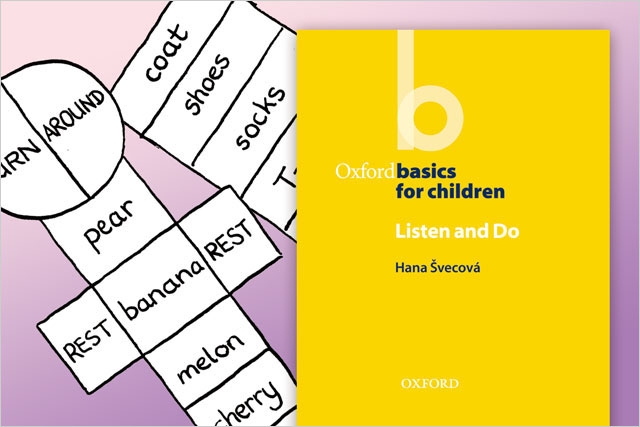
Enjoy Learning English with Hopscotch
This activity has been taken from Listen and Do, part of the Oxford Basics for Children series, and helps young learners practise a set of words they are familiar with.
Listen and Do is a collection of classroom activities for children aged 4—12. The activities help learners understand language by listening to instructions and performing them. Movement and physical involvement are natural and non-threatening ways for children to learn. By listening to instructions and following them, children can develop understanding before they speak. Physical response not only activates their memory and teaches them to think in the language, but it also makes learning enjoyable, playful, and fun.
The book is a useful resource for teachers of young and very young children. It provides teaching ideas and materials for a range of 'listen and do' activities.
・Hopscotch: Activity sheet (PDF) 100KB
Quality and excellence in teacher training – how IIEEC courses enhanced my classes

About the author
Noriko Hattori is the owner of English Factory in Nagoya and also teaches at a public elementary school. She attended the IIEEC – OUP Teacher Training Certificate Program in 2015 and has regularly joined IIEEC Osaka study group meetings since then. She is currently taking the Model Action Talk (MAT) METHOD 6 module skill-up training programs.
How do you teach "What's this? It is a/an ___." to four year olds? I found the best way to do this at IIEEC-Oxford University Press Teacher Training Certificate Program in 2015. Most Japanese children have about an hour of English lessons per week. They don't have much chance to practice English outside of the classroom. This program helps you to teach English effectively in a minimum period of time.
Attending IIEEC - Oxford University Press Teacher Training Certificate Program
There were 6 modules of 12 workshops with Skills Practice sessions in how to hold picture cards effectively, introduce vocabulary, and how to teach both sentence forms and question forms. Throughout the workshops, I learned how to use the Model Action Talk (MAT) METHOD. The MAT METHOD was created in order to teach English to children in a systematic and organized way that gets immediate results in all of the four skills of listening, speaking, reading and writing.
The effects in the classroom
Since I took the program, it's amazing to see my students actively trying to TALK in English. One student, four years old, pointed to his water bottle and asked me、 "What's this?" He just wanted to know how to say "bottle" in English. A seven year old kept asking and pointing to everything in the classroom, "What's this? What's that?" A five year old told me that his arm was really tired from doing the gestures, but he was happy about it. A nine year old who had forgotten his pencil said, "I want to borrow a pencil." without any prompting. He had practiced "I want to" with different verbs and "May I borrow a pencil?" previously, but somehow he was able to put them together and make the correct sentence by himself. Overall, my students have become a lot more energetic, excited and creative than before. They have been learning "Living English" which uses natural speed, rhythm, intonation and correct pronunciation in a way that they really enjoy. By making my teaching more focused, it has become easier, more effective and more rewarding. Not only do the students improve their English for their own sense of accomplishment, but as a teacher I feel the happiness of a parent watching her child grow.
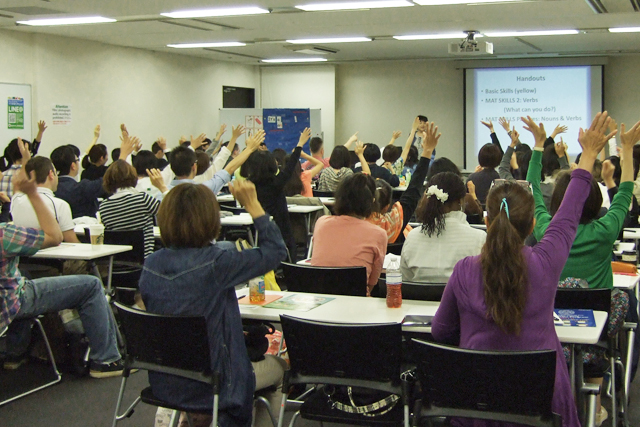
Why I recommend IIEEC
This program will be an eye-opener for everyone, with the fun and unique MAT techniques that make it so easy for kids to learn even difficult things quickly. Students learn to say the target language naturally with speed and rhythm, using gestures which help them remember better. They also learn to read and write in a special way as they speak. I recommend this program to all teachers, and those who want to be teachers, so that we can make our students react spontaneously and become fluent, interested, motivated and active speakers of English.
·Learn more about IIEEC-OUP Teacher Training Certificate Program 2018
Project Packs
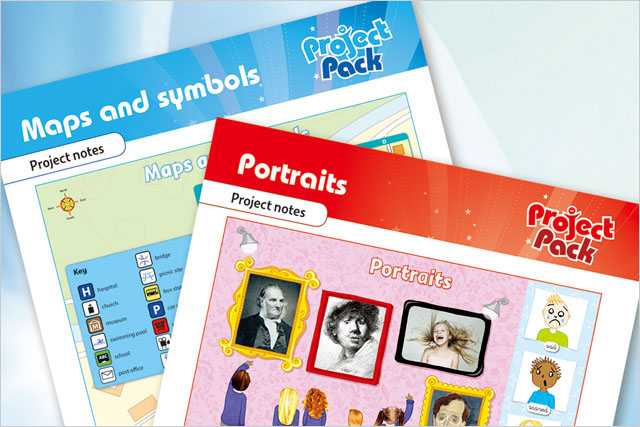
Here are some project ideas that help students develop important skills and support teachers who need additional classroom material. These projects also encourage students to think critically and explore the world around them. Download now!
・Portraits: Activity sheets (PDF) and audio (MP3) -15MB
・Maps and Symbols: Activity sheets (PDF) and audio (MP3) – 21MB
Everybody Up Way! Part 5 - Personalization: The Biggest ‘P’
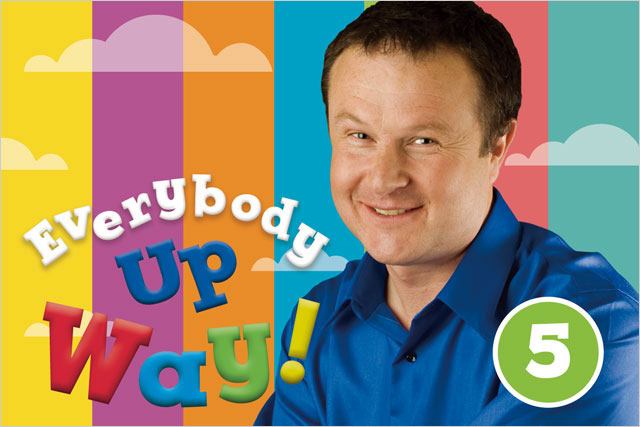
My grandmother used to say that if you find yourself in a conversation that isn’t flowing smoothly, the best thing to do is ask the other person to talk about themselves. This will usually get things going. People tend to love to talk about themselves and it is the topic on which they are likely to have a lot to say. “What about you?” is definitely the most useful phrase in any language.
Children learning English are no different. Along with presentation, practice and production, personalization is a big part of Everybody Up. In fact, we think it’s one of the reasons the course has been so popular.
We want to give every child the opportunity to express themself in English. We want them to be able to tell the stories of their own lives. Not just because it’s fun and interesting, but also because this is what will help them most as language learners. Students’ unique and individual lives are a great resource for us as their teachers. Every student has different stories to tell and everybody appreciates being given the chance to tell them.
Through sharing about their likes and dislikes, their pets, their hobbies and so on, children become more motivated to speak English. They grow in confidence when they can see a role for English in their own lives and in their own worlds. Furthermore, personalisation activities strengthen the relationships in your classroom, including the links between students and the links between the teacher and students. It really is a process of “getting to know you”.
Everybody Up is full of photographs of real children. They make the pages come alive and feature on all the covers too. These children are the Everybody Up Friends and they play a big part in the personalized learning of the course. They are age-appropriate to the level of the course as well as being of all ethnicities. Everybody Up is a course for the whole world.
These Everybody Up Friends appear throughout the books and ask direct questions to the students at the end of every lesson. These questions are simple, such as “I like chicken. What about you?”, “What places do you clean up?” or “When do you eat breakfast”. My favorite Everybody Up Friend question comes at the end of the Dinosaurs CLIL lesson when the Everybody Up friend ask students “Do you have a pet? Does it have claws?” That always reminds me of my own dog’s sharp little claws!
With young learners, the answer is "very important indeed". More so than any other age group, kids depend on what they see in front of them. If you give them poorly designed, boring looking materials they will respond by being bored. If you don't value the materials you are giving your students, they won't value them either. Throughout the creation of Everybody Up, design has been one of the team's most important priorities – above all because it aids learning.
In Everybody Up Second Edition we also have four project pages in every book. These are all personalisation opportunities for students. Of course they are also creative activities that lead to great in-class communication. For example, in a project form Level 1, we ask students to make an “All About Me” book. In Level 4, there is a fun project where students draw a map of a dream island and think of some vacation activities to do on the island. All of these small opportunities to tell their own stories build up to make students happier, more confident English speakers.
That's the Everybody Up Way!
Everybody Up Way! Part 4: Looking Good, Learning Good
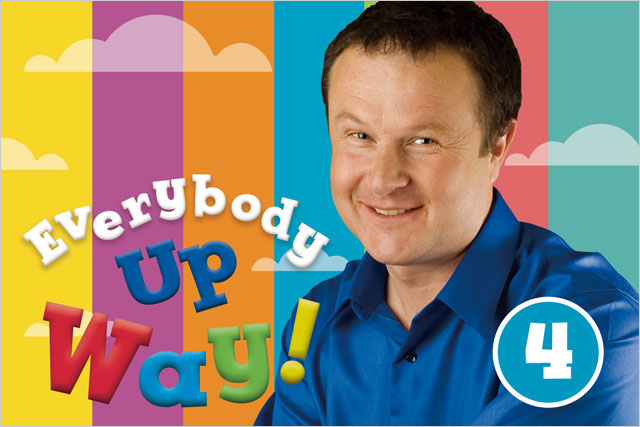
How important is design?
With young learners, the answer is "very important indeed". More so than any other age group, kids depend on what they see in front of them. If you give them poorly designed, boring looking materials they will respond by being bored. If you don't value the materials you are giving your students, they won't value them either. Throughout the creation of Everybody Up, design has been one of the team's most important priorities – above all because it aids learning.
Color is fundamental to how we see the world. Like animals picking fruit in the forest, we notice, and make choices based on color. Quality printing on high quality paper makes a big difference to kids. It's part of how they get information in the world and how they naturally learn.
Good layout is an important part of how a lesson flows on the page. We all like to see where we are going and where we have come from. This is also a key part of how we learn. Everybody Up went through many versions before we settled on the current page layouts. We were looking for clarity, consistency and for the design to communicate the excitement of learning.
Photography plays a vital part in opening up our classrooms, linking them to the wider world. Good photographs bring a subject alive. This is particularly the case with the Everybody Up CLIL lessons where we use a lot of photography. We also try to use as many high-quality images as possible in presenting vocabulary. Students will remember it better that way.
Pictures of real children doing real activities are also very motivating for learners and fun to look at. These pictures are taken in a studio to model activities, and give Everybody Up a real-life feeling that kids pick up on. At the end of each lesson, a photograph of an Everybody Up friend asks students direct questions, modelling the language in a real way.
Good illustration of stories and the characters in them make them easier to identify with. In Everybody Up we have stories in Lesson 3 of every unit. These stories teach language in context as well as 16 important core life values such as "Be Kind", "Be Friendly" and "Be Fair". They stories are beautifully illustrated and this makes the events clear and fun to read. The illustrated role-plays also help to reinforce learning.
Increasingly, other aspects of design are coming into play. Animation of the songs and stories has added richness to Everybody Up we could only have dreamed of until recently. Real world, documentary style videos and posters are making learning even more immediate and interactive. Websites and Online Play are giving students the chance to practice at home. It's exciting because all of these things aid learning.
An Oxford University Press designer once said, "I like to make books look like candy." Children, more than any other age group, are visual learners. The younger the learners, the more important the visuals are.
That's the Everybody Up Way!
Everybody Up Way! Part 3: The Power of Songs
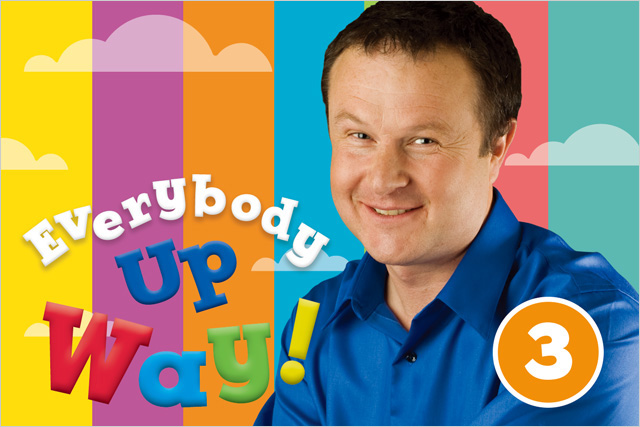
I have just returned from presenting Everybody Up to teachers in Beijing, China. Just before my talk was due to start, a seven-year-old girl called Fiona came up to me and asked if she could sing me a song. She was there with her mother. I was delighted of course and knelt down to hear to her sing "Edelweiss" from The Sound of Music all the way through. I confess that a tear rolled down my right cheek. Apart from her beautiful singing, and the effort she had clearly put into learning the song, and the kindness in singing it for me there was something else…
"Edelweiss" is the song that my own mother used to sing to me when I was a baby. Here it was so far away in distance and time from where it had entered my life but the feelings it created were just as powerful. It really knocked me off balance, connecting with something deep inside me.
When I told Fiona's mother this, she told me that she had always sung "You Are My Sunshine" to Fiona when she was a baby. Another tear rolled down my cheek, (my left one this time). Because you see, that is the song that I always sang to my own two children when they were babies. The 300 teachers attending the event were surprised to hear of this double coincidence. We sang both songs through twice and there wasn't a dry eye in the house. Songs have that power to make a deep emotional connection. Our sing-along brought us all together.
Songs are a very important part of Everybody Up." The songwriter team includes Grammy winner Julie Gold who says "I feel lucky to be writing songs that make learning fun for children around the world". We are lucky to have her. We are also proud to have songs from the Super Simple Songs team, Devon Thagard and Troy McDonald. They "love to create songs that help children learn with confidence". Another interesting member of the team is Ilene Weiss. She works in hospitals, helping to heal children with music and laughter. She says, "I like to create songs that make children feel better". Finally, the aptly named Red Grammer whose songs, such as "I Like Chicken!" are really active and fun. Kathy Kampa and Chuck Vilina, Everybody Up co-authors are also active songwriters and performers.
It was fitting that Everybody Up was launched with a musical fanfare. The Global Sing-Along connected hundreds of classrooms around the world, with children singing the same songs together. It was beautiful and it was moving and they learned a lot of English. That's the power of songs.
That's the Everybody Up Way!
Everybody Up Way! Part 2: CLIL is Easy!
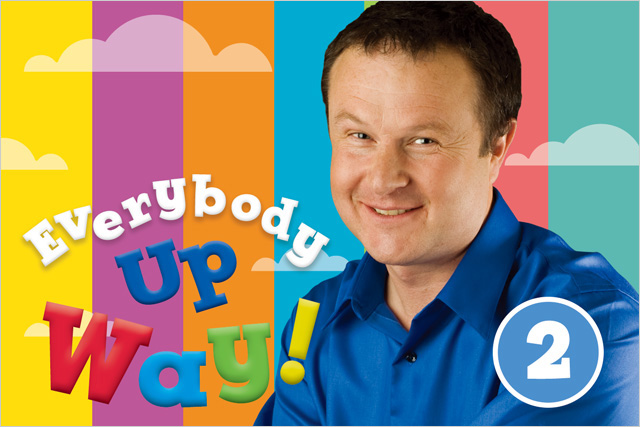
Content Language Integrated Learning, (CLIL) is very popular these days. CLIL means that we learn language while learning about something. Some teachers worry about CLIL. They think that it’s too difficult for them. Actually, using CLIL methodology is fun and pretty easy. What’s more, students love it because it makes a link to the wider world beyond the classroom.
People talk about Hard CLIL and Soft CLIL but you don’t need to worry about that. There is Soft CLIL in every Lesson 4 of Everybody Up. It's where we make cross-curricular school subject links, learn a little bit of extra vocabulary and grammar and use the language students already know.
There are all sorts of CLIL lessons in Everybody Up covering many of the school subjects – Science, Art, Social Studies, Math, Health and so on. They are the highlight of each unit. Students get to use the language they have built throughout the unit in a real world context. That’s very exciting for them. They can see their English in action!
My personal favourite CLIL lesson from Everybody Up is "Dinosaurs". It's a beautifully illustrated lesson in Level 4. We learn some new vocabulary to talk about animal body parts such as feather, tail, claw and wing. Then we learn about how different dinosaurs lived, what they ate, how big they were and what they did. We also learn some cool dinosaur names such as Microraptor! Students end the lesson by talking about their own pets.
So, you see, CLIL is really nothing for teachers to worry about, whatever their level of experience or confidence. It’s just a way of developing students’ language and learning. Most importantly, CLIL puts students’ English into practice in an interesting real world way.
That’s the Everybody Up way!
Everybody Up Way! Part 1:
6 Simple Ideas to Motivate Your Students using Linked Language Learning
To mark the launch of the Everybody Up Second Edition, author Patrick Jackson shares some practical ideas about Linked Language Learning, the concept at the heart of Everybody Up, and the reason for its success.
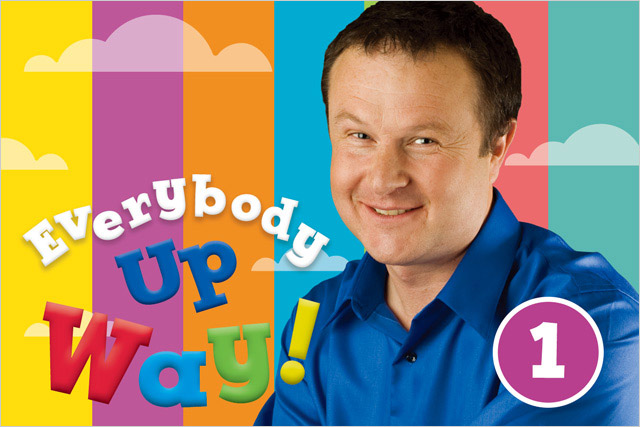
These days, I live and work in Ireland. Near my home, is Newgrange – a huge mound of rock and earth that's over 5,000 years old. At dawn, on the shortest day of the year, everyone gathers to see the sun's first light shine along a passage and light up a chamber in the mound.
This special moment reminds me of how our classrooms should be. We should connect them to the wider world beyond their walls. We should allow light to shine in from outside. And, in turn, our classrooms will become places from where light shines. They will become memorable, happy places that encourage and empower the children who are lucky to come there. That is what we hope anyway!
Young children spend rather too much time in classrooms these days, often sitting unnaturally still for hours every day. Many of them spend a lot of time after school in other classrooms before they go home. A lot of them are expected to study at home as well. They can easily become bored and lose motivation. They can become unengaged. They can become tired of the whole learning process and switch off. Our greatest challenge as educators of children in this competitive and systemised environment is to find ways of stopping them becoming burnt out and simply giving up. It's a sad but true reality.
How are we going to create lessons that stand out and that our students look forward to and become excited by? How are we going to motivate and inspire? I believe that the best way to reboot our students is to think of ways that the classroom can be linked to the wider world. This is the thinking behind everything we did when we created Everybody Up.
Here are some ideas:
1 Teacher Show and Tell
It's really interesting for students to see their teacher bring something curious into the classroom. This could be anything really so long as it's something the teacher is enthusiastic about. This enthusiasm leads to students sharing their own interests and passions in turn.
2 Snail Mail
Of course, nowadays we can communicate with people all over the world so easily using the Internet. Much more exciting than an email though is an old-fashioned parcel containing snacks and stickers from a classroom in another country. Picture postcards from around the world are also really exciting for students to get. It's very easy to arrange this sort of exchange and your students will be really motivated by it. Check out epals.com to find a classroom to twin with and get started. I have used it successfully over the years as a way of making connections with like-minded teachers around the world.
3 Decorate your Classroom
Set the scene by making your classroom a Global HQ for Linking. A notice board in the classroom is a good place to display students' projects and you can put posters up on the walls from different parts of the world. A good way to get these is to write to foreign embassies and tourist offices in your country. They are always happy to send their publications to educators.
4 Hold an International Day
Plan and hold an International Day for your class. Students work individually or in pairs and research a country to tell their classmates about. If you can get the parents involved, it may even be possible to arrange some foods from those countries. Students can draw flags and learn a few phrases of their countries' languages. It's great fun and helps create an international mindset.
5 Our Town Video or Powerpoint
Students will enjoy making a video about your city, town or village in English and sharing it with other classrooms via the Internet. You can also use PowerPoint very effectively for this sort of project. This can be as simple as a series of photos of local attractions with captions in English or it could be a more sophisticated with students acting as anchors. It's a great way to ‘Englishify' your local surroundings.
6 English Hunting
Ask your students to find a number of examples of English in their surroundings outside the classroom. Simply by doing this they will identify the fact that English is happening all around them and is not just something that takes place in lessons. If your students are old enough to have their own mobile technology they can "hunt" English and bring it to their next lesson.
These are just a few of the many ways that you can start to connect your classroom to the wider world. As a teacher, it's a state of mind that you get into and ideas will keep coming to you. In fact, once you become a Linked Language Learning Teacher, there's no going back! These projects also build from year to year and become part of your classroom's culture. It's fun showing your new students the work of the previous year's class. These sorts of activities are certainly the best way to get your students engaged and developing a strong sense of the purpose of learning English. They are also the best way to create memorable learning moments and experiences for our students. And of course, most importantly, they are all really fun.
Patrick Jackson is one of the authors of Everybody Up. In this series of articles, "The Everybody Up Way" he shares the thinking behind this popular series.
Foreign Language Education in Public Primary Schools: Four Important Trends
Since the summer of 2015, OUP Japan has been working with a local board of education to provide materials and training for gaikokugokatsudo classes in the city of Otsu. In this article, OUP teacher trainer Rob Peacock talks about four important trends in English education in the public sector.

English education in the public sector is undergoing many important changes, especially at primary school. From the summer of 2015, Oxford University Press Japan has been working with a local board of education to provide materials and training for gaikokugokatsudo classes in the area. As I have taken part in this exciting program by observing classes and running workshops, I have learned a number of useful lessons about trends in education which are likely to have a big impact on all teachers in Japan.
1: Extending study to the middle and lower grades
At present, the national curriculum provides gaikokugokatsudo classes for 5th and 6th grade students, and this will be extended to the 3rd and 4th grades in the new curriculum. In the city which we are working with, all grades take 45 minute koma classes using the best-selling Oxford primary course Let's Go. The 5th and 6th grades are taught once a week and 1st~4th grades once a month. Positive learning experiences early on in a child’s education help to motivate students to keep studying foreign languages as they become older.
2: HRTs and ALTs team teaching together
Koma classes are taught by the homeroom teacher, who is assisted by an ALT. It is very important to the local board of education that the homeroom teacher and ALT team teach effectively. We have provided an effective training program to empower homeroom teachers to take part in classes proactively. This has involved general training sessions for teachers in the area as well as school visits, in which we observe classes and run workshops for all teachers at the school. I have spoken with many teachers who used to leave the entire lesson to the ALT and now feel confident leading sections of their classes.
3: Increased exposure to English through modules
Many local boards of education are introducing short module classes, often held at the beginning of the school day or after lunch time. Schools in the city which Oxford is working with usually hold 10 minute modules 3 times a week. There are 3 types of lesson which we recommend; interactive story telling with The Oxford Reading Tree, songs and chants using Jazz Chants, and games using the Let's Go teacher and student cards. These extra classes increase students’ exposure to English, give extra chances to practice communication and help show students how learning a language can be fun.
4: Focus on communication through fun activities
The three main targets of the national curriculum at present are attitude towards communication and willingness to communicate (コミュニケーションの関心・意欲・態度), familiarity with foreign languages (外国語への慣れ親しみ), and noticing differences in language and culture(言語や文化に関する気づき). In classes, these important areas are covered through games, songs, projects, interactive storytelling, etc. During observations, I have seen teachers using a variety of fun and productive games in the classroom. One particularly successful activity I saw was to practice phrases for introducing a friend (This is my friend ~ from Let's Go 1 unit 3). For this class, the teacher had prepared some masks of famous characters such as Pikachu and Funassyi. Students made pairs, 1 student in each pair wore a mask, they found another pair and introduced the student wearing the mask as that character (This is my friend Funassyi). The students really enjoyed this activity, and were talking excitedly in their pairs about which character they wanted to meet next (Let's meet Pikachu next). Because students have so much fun during these activities, they use the phrases very naturally.


